Jim Clark in a Lotus is poetry, a symphony.
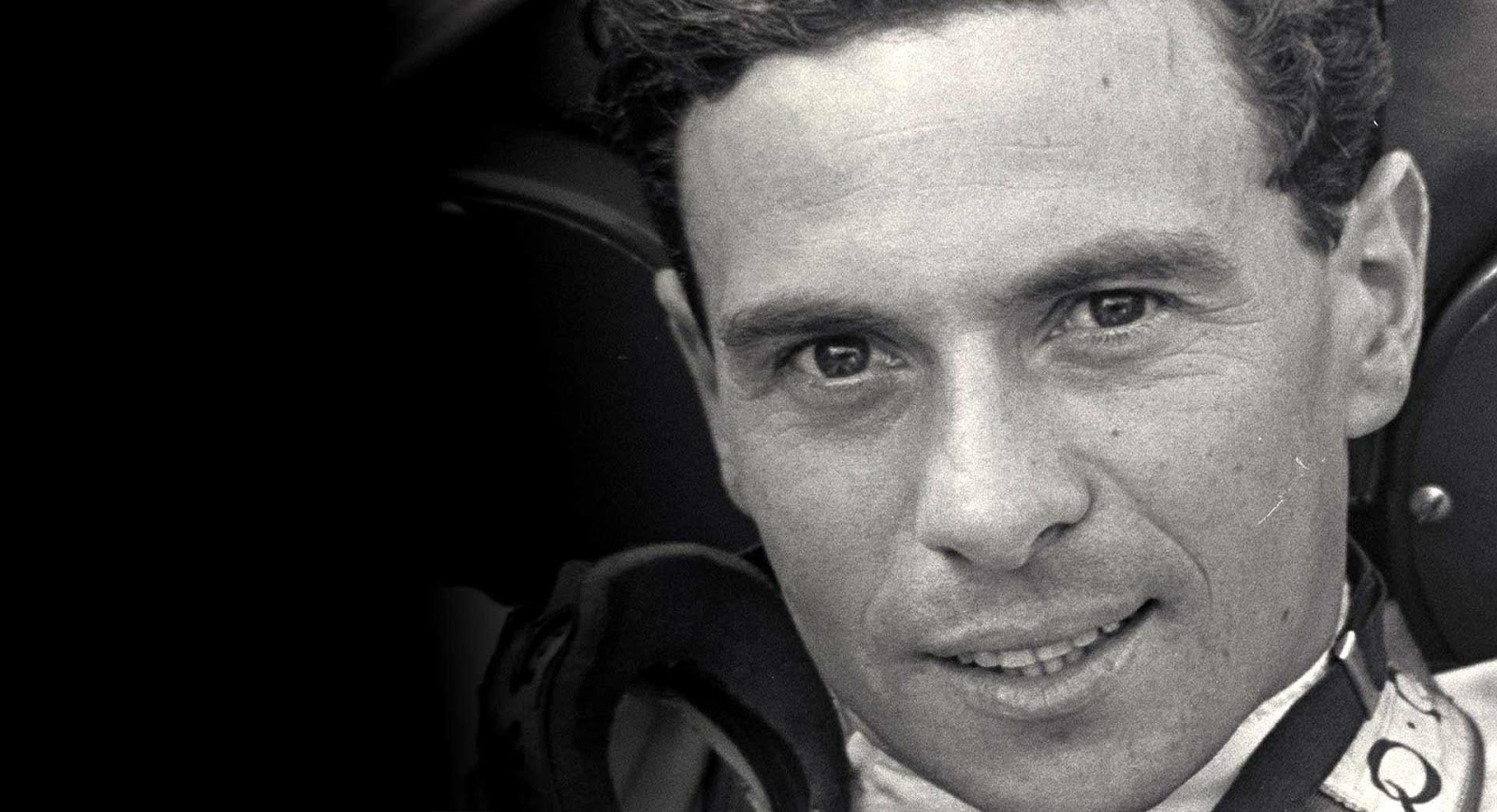
The Senna of the 60s. Jim, a great and humble champion, was a pure of the steering wheel.
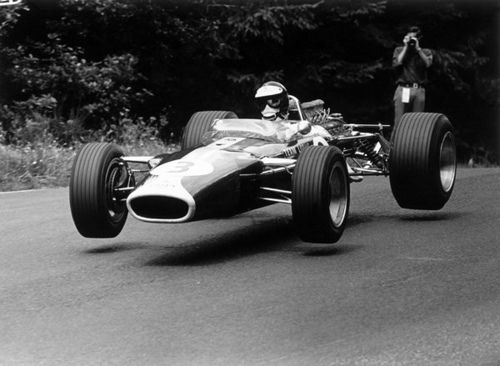
And he drove the right car for him, the very light and very English Lotus. Two legends in one.
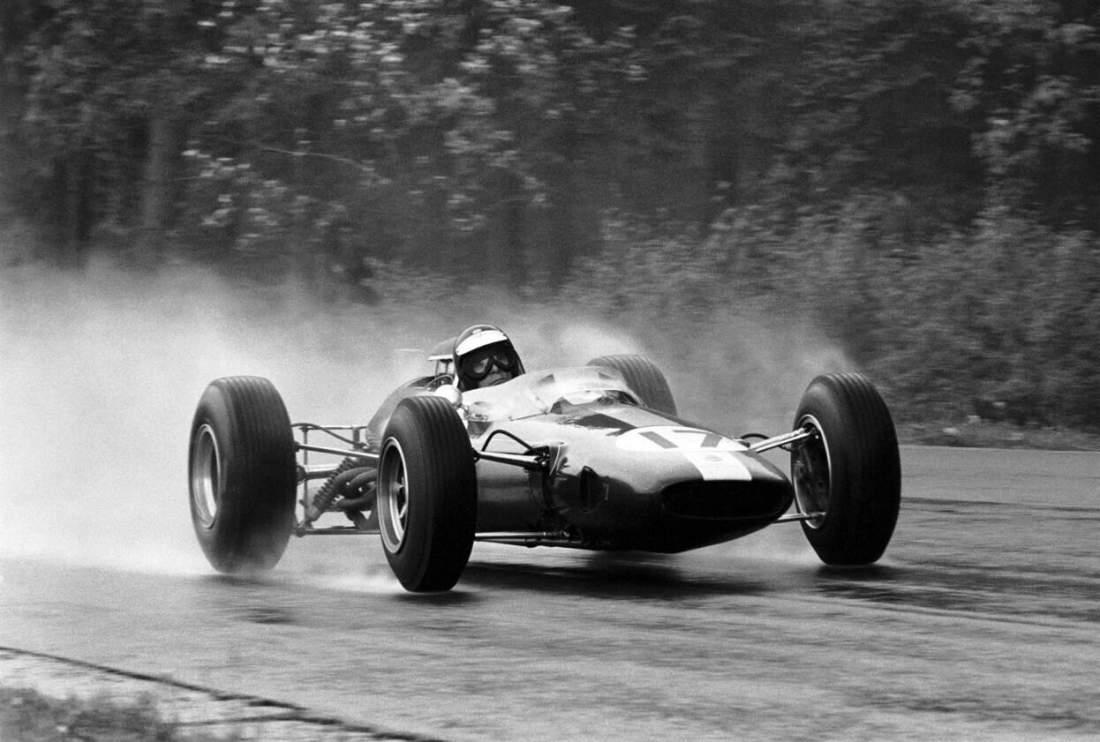
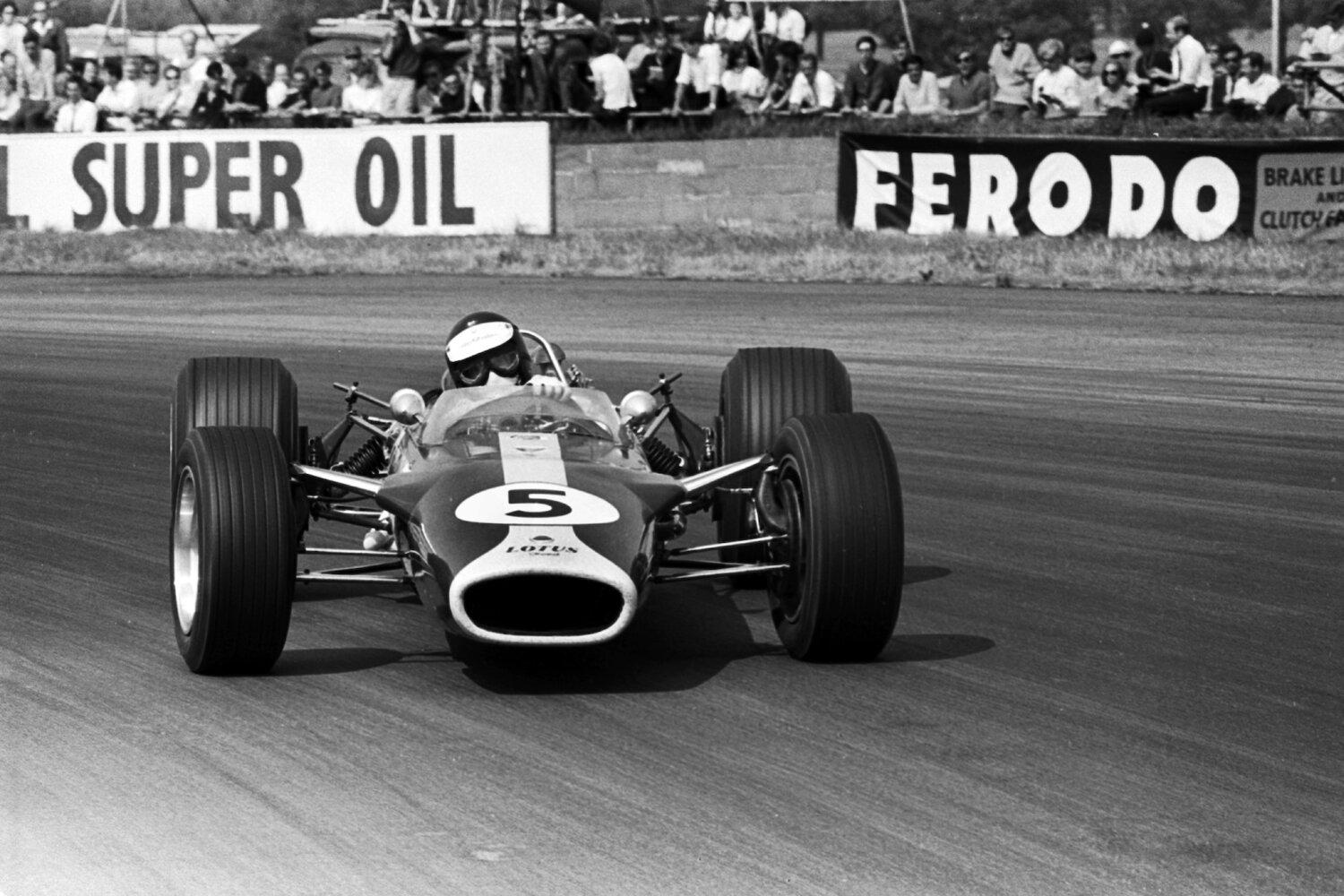
Jim, the shy Scottish farmer chronically undecided in life, in the car was transforming himself.
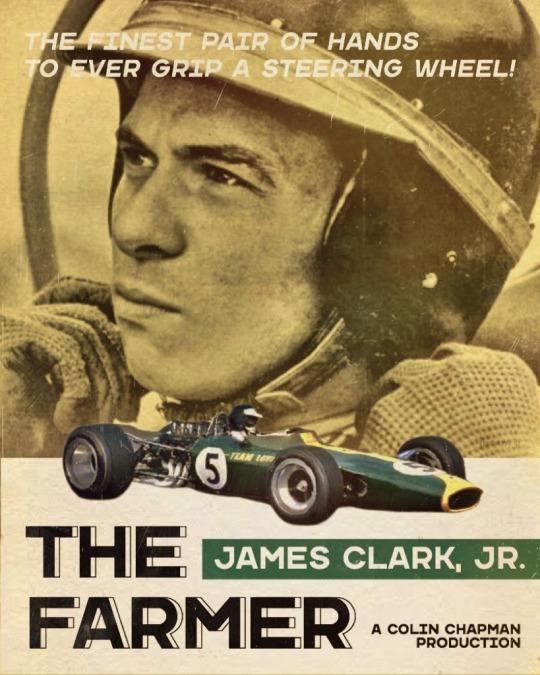
In his week-ends off from the farm he just wanted to drive, faster than anyone else. And he did it. He was jumping from one car to another, immediately taking it to the limit. He had a spectacular drive, raising the internal front wheel when cornering.
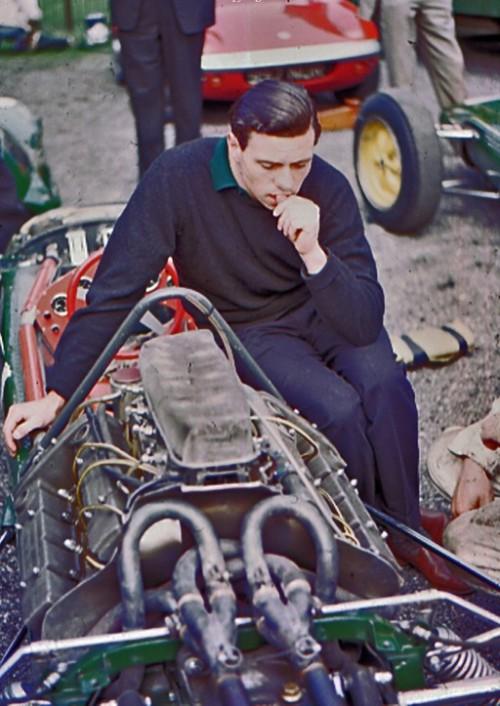
In the Lotus 25 he was practically unbeatable, the quickest man on wheels. 72 starts and 25 wins, an incredible record. He was returning to his farm as soon as possible.
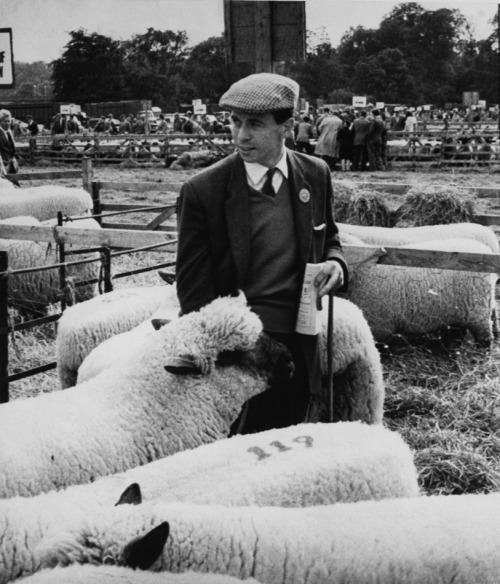
He genuinely loved it, his sheeps. But he loved racing more, the older sister said.
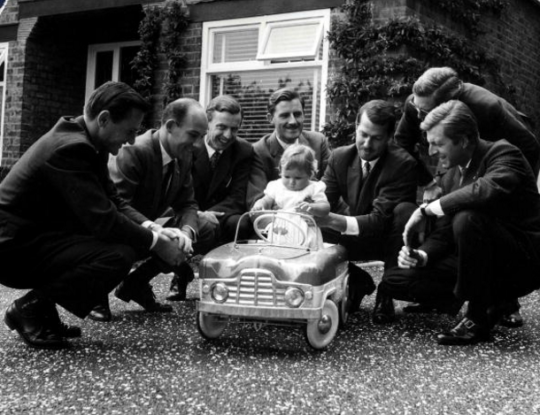
Bruce McLaren, Stirling Moss, Jim Clark, Graham Hill, Damon Hill, Lorenzo Bandini and Wolfgang von Trips.
Jim Clark, Jackie Stewart and Graham Hill, the three friends, three gentlemen drivers.

John Whitmore, Jimmy Clark and Jackie Stewart.
They went on vacation together with wives and girlfriends, they were a family. “The three of us together were terrific. They called us The Three Musketeers,” Jackie Stewart said.
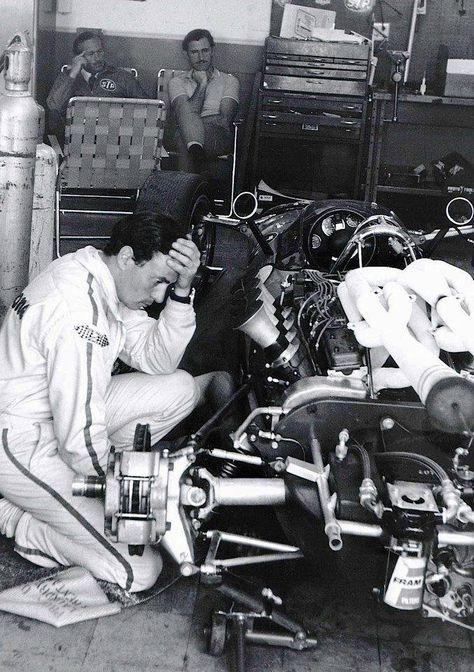
Jim Clark, Lotus-Ford 38, with Colin Chapman and Graham Hill looking on from the back of the pits.
Clark raced for Colin Chapman and never raced for anyone else. And Chapman said about him: “I was very, very close to Jim Clark, he was I would say my best friend, the best friend I ever had off the track. Jimmy was probably the greatest racing driver there have ever been, a very rare combination of fantasticly high intellect, fantasticly high ability with a tremendous concentration that, in my ten years racing experience, any other racing driver had.”
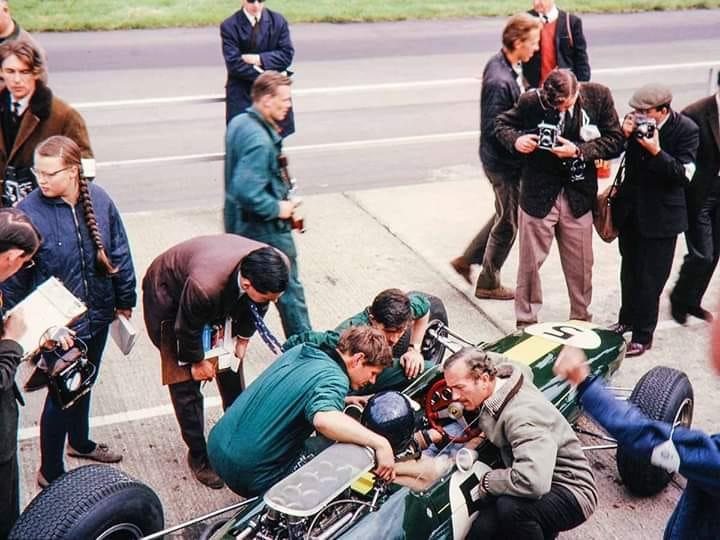
"Clark's talent was even greater than he showed us. He never reached his limit. He only used 90% of his talent, which makes the gap between him and the other drivers even bigger." Colin Chapman

"Jim Clark drove with a unique style, he was able to conserve his energy and the car, but his pace was still so high that it took him to win races. I never gave him orders or advices while he was racing. All I had to do was give him all the information before the race, he would take care of the rest." Colin Chapman
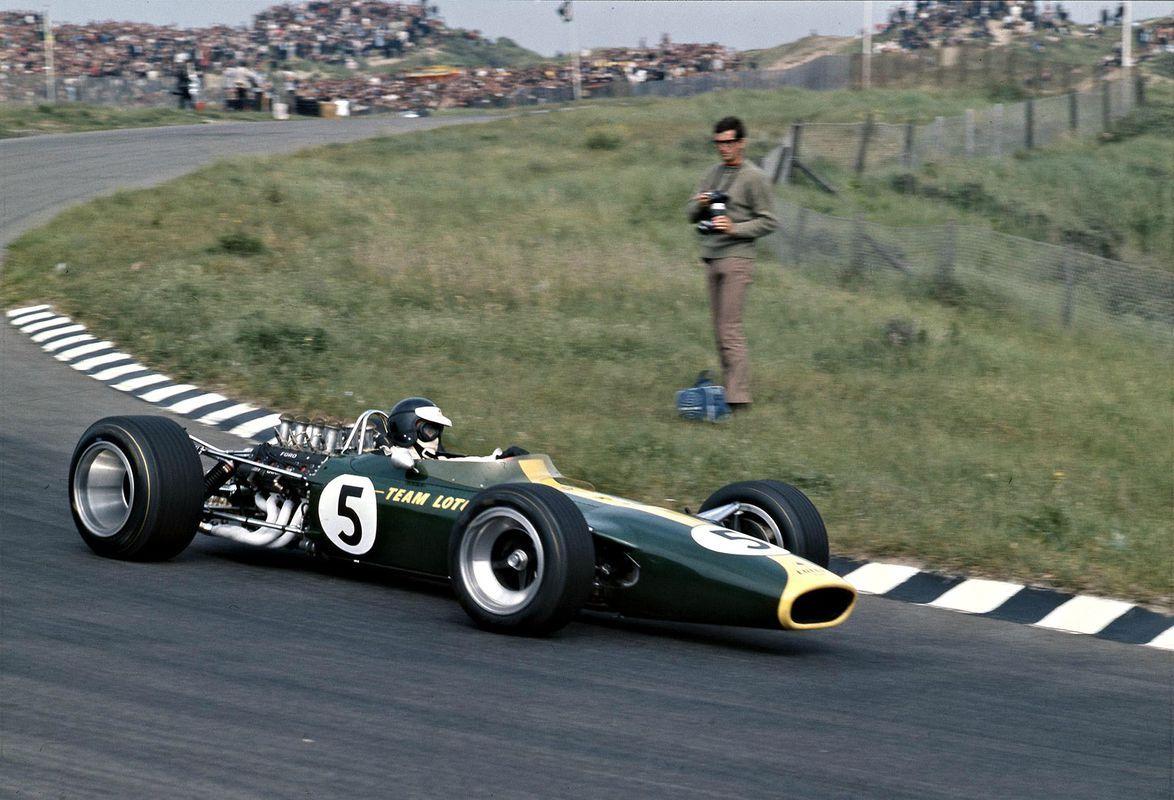
“Jimmy was so unlike any other racing driver. He was very special. To be on the podium with Jim Clark was a privilege. In his driving he was so smooth, he was so clean, he drove with such finesse. He was a special man, one of a kind I have never seen since.” Jackie Stewart
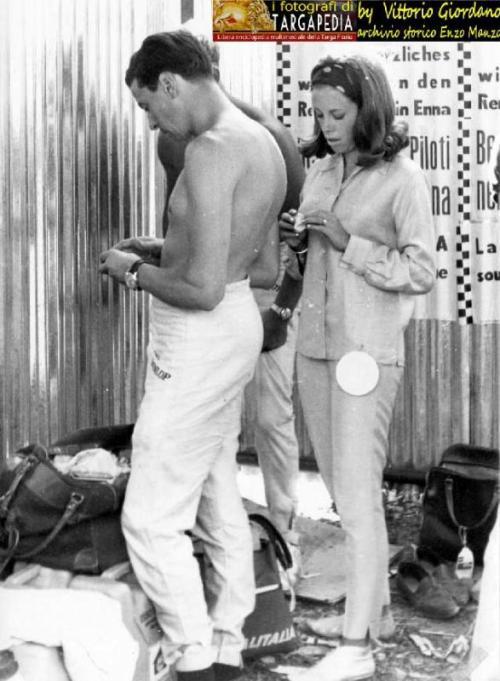
The lady rubbing something into Jim Clarks's back here Richie Ginther's sister. Source forum-auto.com.

Jim Clark and Graham Hill.

Jim Clark and Graham Hill.
“He was a very tough opponent.” Graham Hill

“Jim Clark was undoubtedly a great one. One of those who can be counted on your fingertips. They described him to me as not very talkative, intelligent, unscrupulous in racing. He was a driver like Alberto Ascari. He hated seeing wheels around him. He started in the lead and walked away. But if he had to stay in the fray, to fight, the game got tougher for him. Better alone, delayed, to catch up. Like in Monza in 1967, when he drove the fans crazy with enthusiasm. I would have liked to entrust him with a Ferrari. Someone told me I could bring him to my team. I never believed it. Clark would never have raced in a non-English car. For him, as for the others who had not had serious accidents or at least physical problems, the first was also the last. Like Bandini. Everyone still keeps wondering why. We have read and heard so much about it: from the mechanical failure, which an X-ray wants to attribute to the shock absorbers, to the conditions of the Hockenheim track, to the tyre, to an unwary young spectator. They also said it about Ascari in Monza. Unfortunately, the well-founded testimony of those supreme moments is always lacking. Perhaps not even the driver, if he had survived, could have explained it." Enzo Ferrari
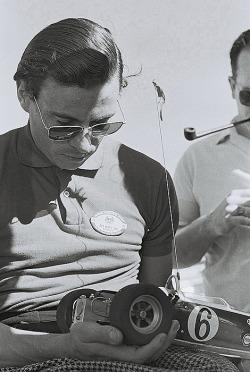
“The greatest natural talent driving today is probably Clark and I say 'probably' just for the forms' sake, because I'm convinced Jimmy is the best in the world. He's a born driver, boy and you know the difference between a born driver and a made driver is the difference between night and day and more.” Sir Stirling Moss, “All but my life” (author: Ken Purdy, 1963).
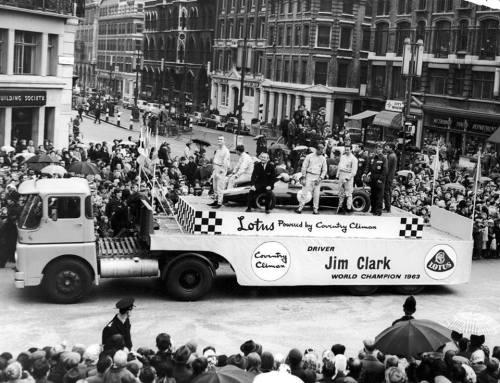
Friends of Jim remained convinced he was close to finally quitting the sport. It was too late. His funeral was moving and people had come from all over the world. Something similar to that of Senna. And, like Ayrton, Jim was too good at driving to have died that way. So, a failure of the car, they say a tire. Unimportant after all. Jim Clark was gone.
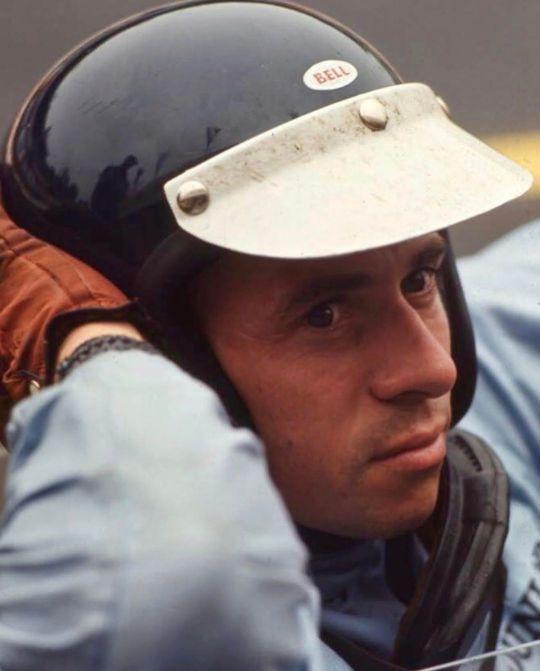
Sally Swart, Jim Clark's girlfriend during the peak years of his Grand Prix career, recalls her time with the quiet Scot.
A couple of evenings before this year’s Long Beach GP the phone rang in the Rolling Hills, California home of Ed and Sally Swart. On the other end of the line was Dario Franchitti, inviting the couple to be his guests at the race.
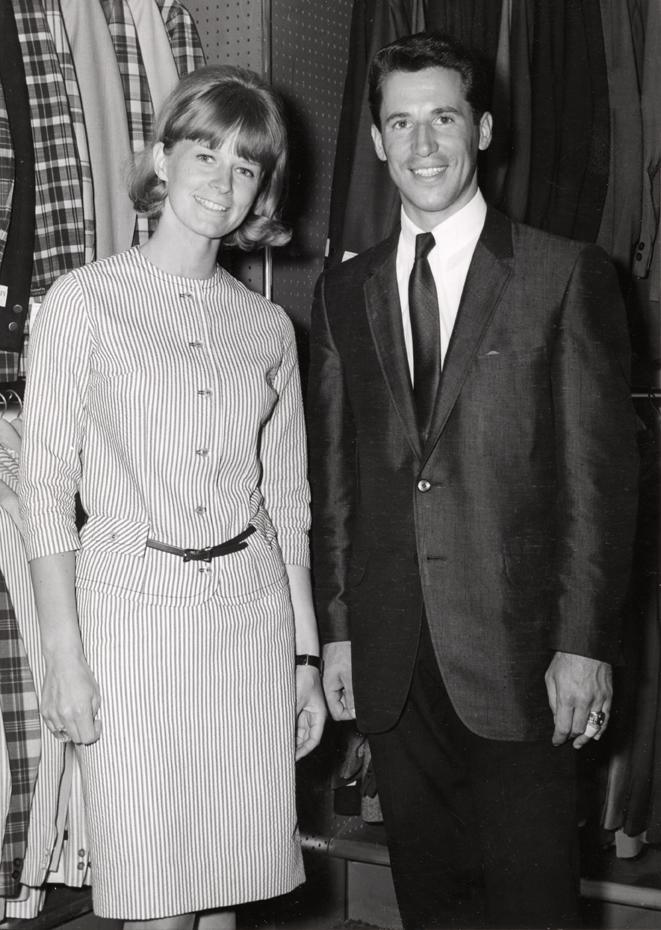
There is no doubt that Franchitti, who was to win that weekend, has a sense of heritage. At the victor’s press conference following the 2007 Indianapolis 500, the emphasis was on the fact that just two Scots had come first at the Brickyard; Dario was in august company, the other being the man who many argue to have been the greatest racing driver of all time, Jim Clark.
At the Road Racing Drivers’ Club dinner — held in honour of Dan Gurney — that took place the night prior to his phone call, Franchitti had made a point of seeking out Sally Swart, whom he had not seen since the Jim Clark Reunion in Scotland in 1993. The reason he was so eager to remake her acquaintance was that between 1963 and ’66, among the highlight years of Clark’s career, Sally Stokes as she was then was the twice World Champion’s steady girlfriend.
In the late 1950s Sally had been part of a circle who founded the Midland Racing Partnership — with drivers such as John Rhodes, Richard Attwood and David Hobbs. On a visit to Mallory Park, the group had been impressed “that five of the seven races were won by this obscure farmer from Scotland who jumped into every car you could imagine, including a Lister-Jaguar.”

Sally, a young photographic model with a passion for horses and theology, moved to London in 1961, maintaining her friends in motor sport who by now included John and Gunilla Whitmore. In the summer of ’63, having been sunbathing in Hyde Park, she walked to the Whitmore’s flat in Balfour Place, just off Park Lane, to keep a lunch date with Gunilla. “I think I was looking rather scruffy. To my horror, Jimmy walked in.” By now the “obscure farmer” was on his way to his first World Championship and, although they had not met before, Sally was well aware of who he was. “Gunilla said she had an appointment and rushed off, leaving us alone. I should have known that this had been plotted, but I was so naive it was years before I discovered it had been a set-up.”
The result was an invitation to the opening night of the film Cleopatra. “We had a good time travelling to the theatre on the tube, all in evening dresses and black tie, with a few friends including Stirling and Elaine Moss.”
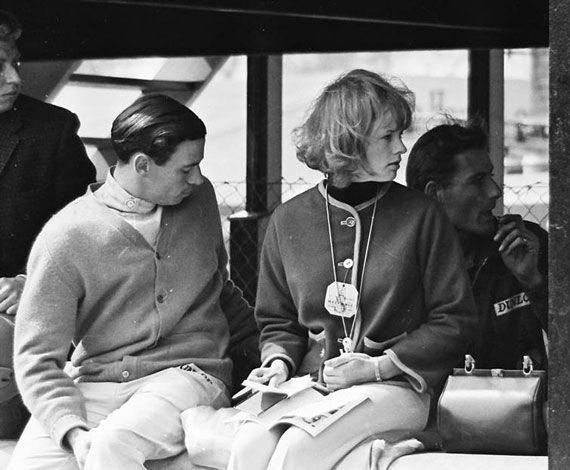
“Quite soon after I went to Brands Hatch with Jimmy.” (Sally remembers he was always “Jim” to his family but usually “Jimmy” to his friends.) Clark was driving a Ford Galaxie with a bench seat. “He slipped on the seat going through Paddock Bend. He said he was all over the place trying to hang on to the steering wheel.” Sally recalls another saloon car memory from the following year. The area behind the pits at Brands was then just a grass field. Clark got into trouble exiting Druids and ended up reversing at speed across the grass and right into the pits. “If you can’t win, at least be spectacular,” he told Sally.
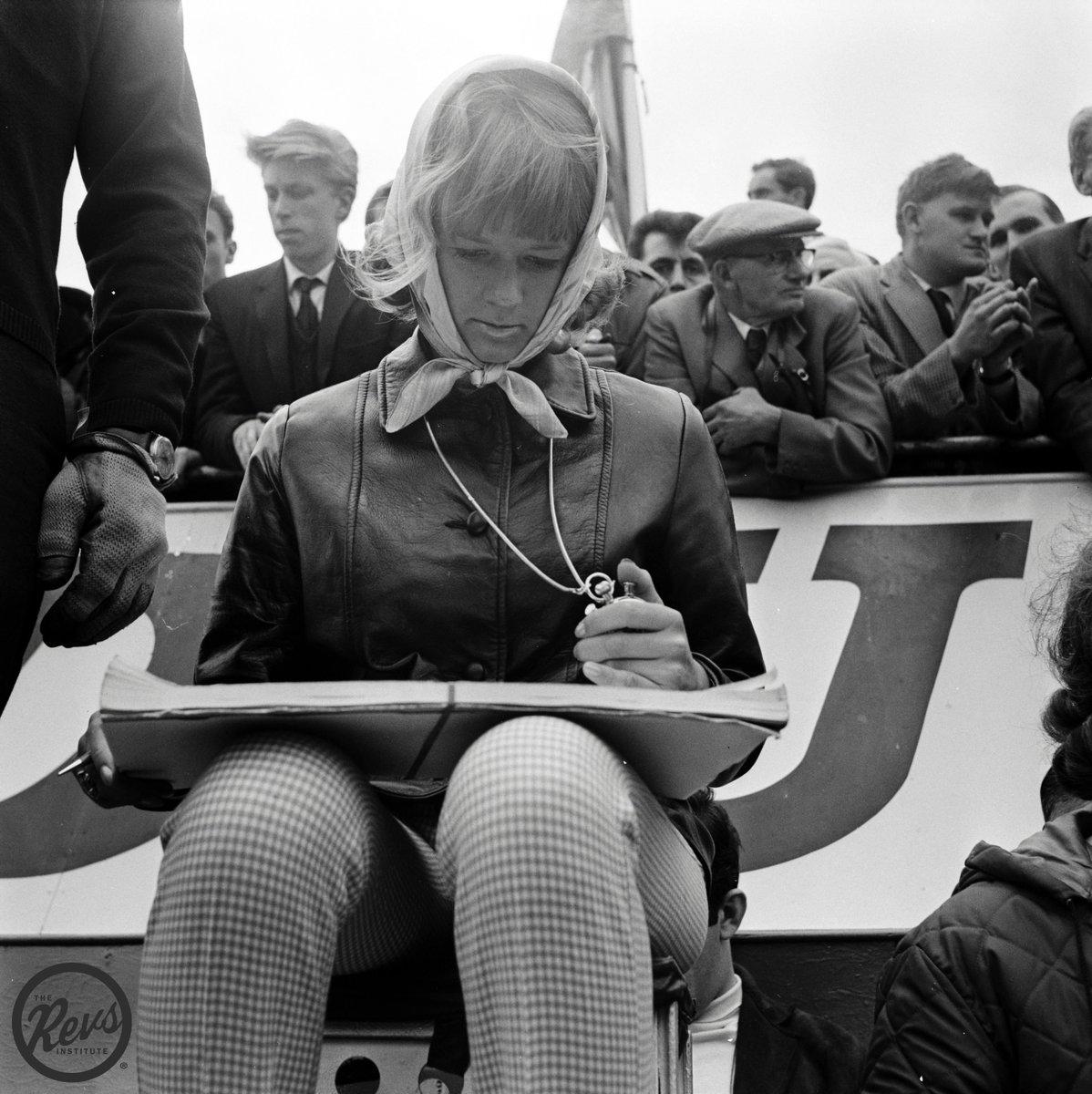
Soon she had been initiated into the Women’s Motor Racing Associates’ Club and the Dog House Club and started carrying out timing duties for Clark.

“Colin [Chapman, founder of Lotus] gave me a lap chart and a stopwatch and set me to work. It helped distract me from worrying about Jimmy. At first I had just a notebook; a proper timing sheet came later.” The pits were a completely different world from today. At one race Sally was sporting the new fashion of stick-on fingernails. “During frantic lap charting, one of these flipped off. I dashed under the counter to retrieve it much to the amusement of the Lotus mechanics. At this point Colin came in, observing ‘Hello, hello… she loses her nail and the whole of the Lotus pit shuts down.”
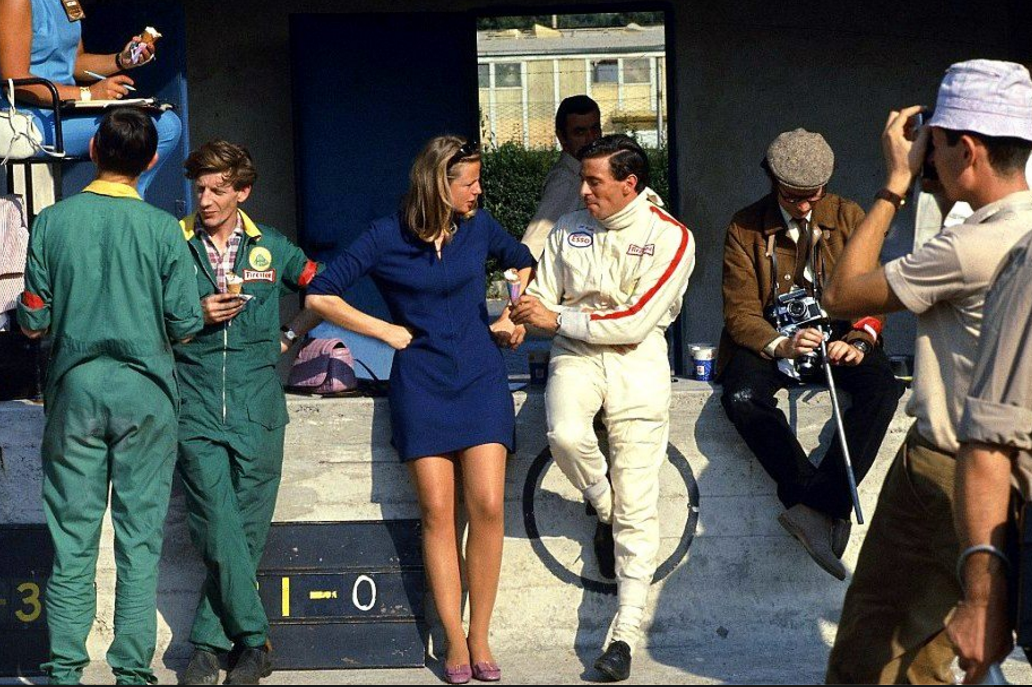
In 1965 Clark notified Team Lotus competitions manager Andrew Ferguson that Sally would accompany him to all of his races. That meant not only the GP but also Formula 2 events and the Indianapolis 500, which the Scot was to win at last. The year before, Clark had come back laughing from the Speedway. He had asked for a boiled egg at the Holiday Inn but was told that he couldn’t have one because the egg-boiling machine had broken down. “He was amused and frustrated by the fact that they could not just put an egg into boiling water and time it.”

Sally did not attend the whole month of May. “Jimmy used to say that it was horrendous, quite boring, but very necessary because he had to set up for the 500.” She recalls Clark telling her how much he liked the actual race at Indy, “because when I am in the lead, I have dollar signs flashing before my eyes”. Being paid for leading a lap was new to him and, as Sally states with an infectious chuckle, “being a Scot he liked to line his pockets”. Other than this, they never spoke about money. However, she does recall one rainy day at Snetterton shortly after he had won at Indy. Walter Hayes, at that stage Ford UK’s PR chief, was “wringing his hands and saying, ‘It’s absolutely ridiculous how little we are paying this guy.’ I merely replied ‘Oh really!”
On the day of the 500 Sally and Colin Chapman’s wife, Hazel, joined Bobby Johns’ family in the grandstands (Johns had driven the second factory Lotus the previous year).
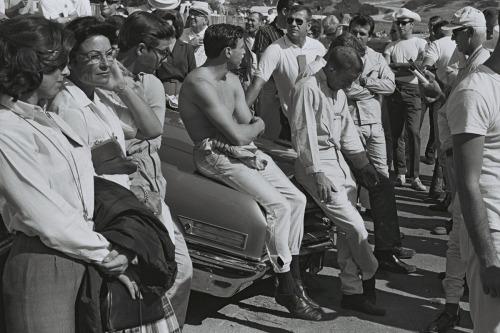
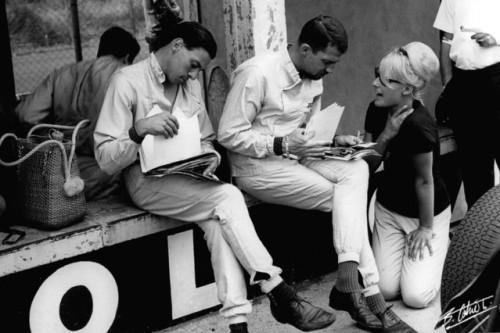
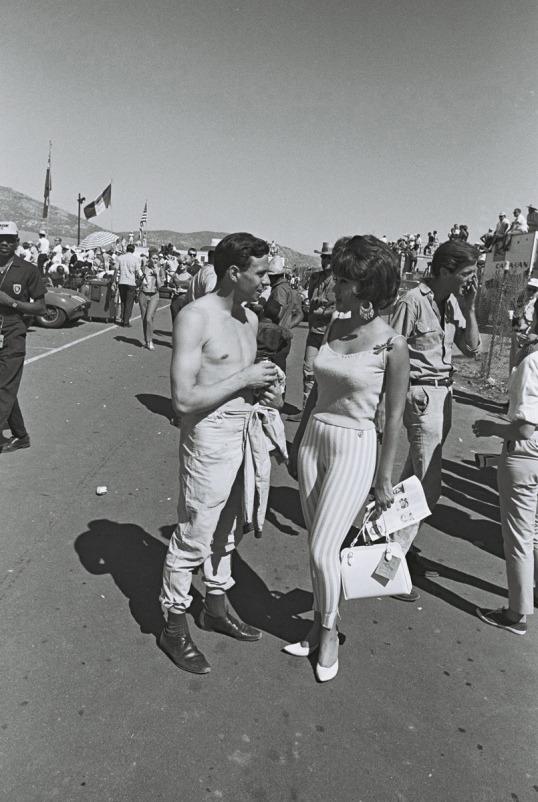
Women were not allowed in the pits or garages then. Lotus chief mechanic Dave Lazenby reckoned that Sally and Hazel ought to be “like the rest of the girls” and hang by their fingernails on the fencing round Victory Lane.
“When the cars came down the straightaway for the first time, Bobby’s sister started crying and I almost joined her,” says Sally. “I had never thought to fear like that before.“ The Indycars had big, fat fuel fillers which we were not used to — remember we didn’t have fuel stops in F1 then. Colin being Colin redesigned the fuel feed from the Esso tank to improve fuel flow. To disguise this he wrapped the fuel hose in tiger stripes. Officials challenged him but he replied with Esso’s advertising slogan of the time, ‘I’ve put a tiger in my tank’ and he got away with it.”
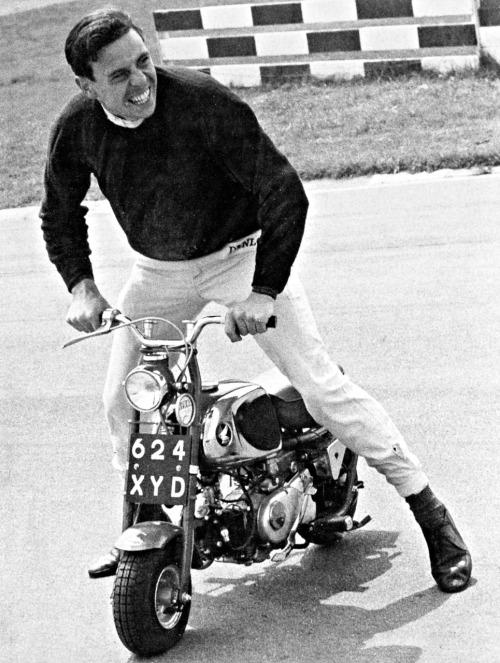
Sally can’t remember how she and Hazel made their way across the track after the race, but they were eventually allowed into Victory Lane. At the subsequent post-race dinner and festivities, Sally and Jimmy could tell that there was a “little gap in the enthusiasm”. Sally has her suspicions: “I didn’t know the half of what had gone on but they had almost tried to prevent Jimmy from winning. Jim had known that and already warned me, ‘they’re not too enthusiastic that I’m here.’ That was rather sad; it dampened the activities for us. However, I do know that he was welcomed in later years with more enthusiasm.” Even today, Sally believes that Parnelli Jones — now a friend and very close neighbour of the Swarts — should have been black-flagged by the USAC officials for shedding oil in 1963 and that Clark should have been given the win that year.
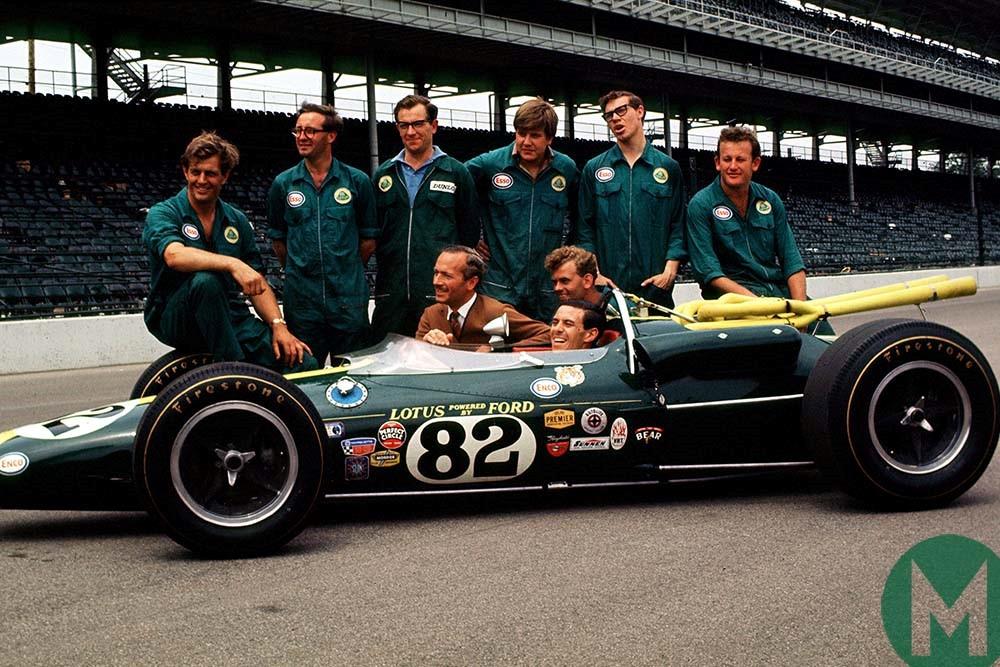
Jim Clark and his Lotus team pose during their 1965 Indianapolis 500 campaign. Clark was victorious that year.
“After the race, I had my picture taken with Mario Andretti, the Rookie of the Year and such a nice young man. Jimmy, I know, was very impressed with Mario’s talent. He thought him very promising.”
The next month Sally, Clark and Mike Spence flew in Chapman’s plane from Luton to the French GP at Clermont-Ferrand. “There seemed to be quite a bit of activity at the airport. We had forgotten that the Paris Air Show was on at that time. The French Government had flown Yuri Gagarin [the first man to travel in space] down from Le Bourget to show off a new plane. There was a civic reception for him. We crept in at the back but it was known from our flight plan who we were. It was only a few weeks after Jimmy’s Indy victory and we were invited into the party and plied with champagne.”
“We saw somebody whisper in Gagarin’s car and he jumped up. It appeared he knew exactly who Jimmy was and that he had just won at Indy. He gave him a hug and a kiss — very unusual in those days — and I shook his hand. He seemed thrilled to meet Jimmy.”
There was more to come that day. To Chapman’s annoyance, Ferguson had booked the group into “some fancy hotel up the mountain” and not their usual abode for Clermont-Ferrand. Sally recalls that the Lotus boss was “driving way too fast” in their hired Peugeot. (“Colin was a wild driver, Jimmy wasn’t. He just drove normally in town but up in Scotland he used to accelerate a bit and enjoy himself.”) Sally was in the middle of the front bench seat with Clark at her side and Spence in the back.
“Colin launched into a right-hand bend, didn’t make it and ended up in a shallow ditch. I went through the windscreen and Colin broke his thumb on the steering wheel. Jimmy climbed out of the door, sat down on the grass and promptly fainted. I pushed his head between his knees. He came to, complaining that I was bleeding all over his new suit.” The men wanted to pull the Peugeot out of the ditch and requested Sally to sit at the controls. It was dark and the headlights had gone. Suddenly they saw that the car was on the edge of a cliff and screamed at her to “hit the brakes”.
“We never did find that fancy hotel and instead went back to where we usually stayed. Bleeding, I was hidden from the press, but it was not good for a model to have a scar on her lip. In the middle of the night Colin and I crept out to the hospital and my wound was stitched up. I had my scarf pulled over my face during the race — which Jimmy won.”
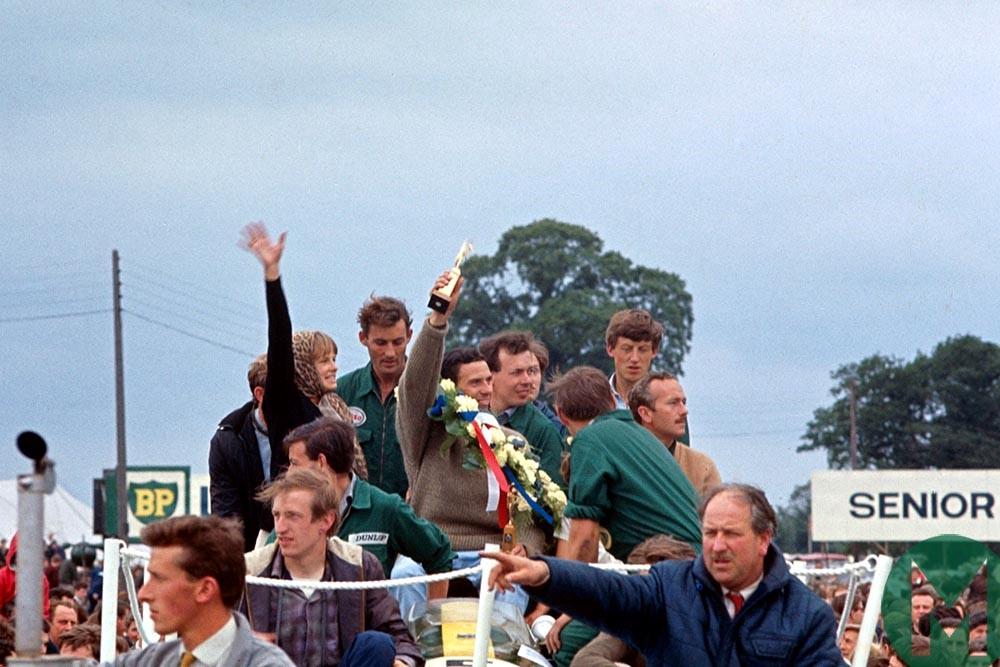
Clark and Sally on the podium after he won the 1963 British GP. Motorsport Images.
At the end of the 1965 season Clark made his usual trip Down Under for the Tasman Championship. Sally, along with Bette Hill and Helen Stewart, joined their men for the Australian leg of the series. However, during the time of the earlier New Zealand races, Warwick Banks had introduced Sally to one of his fellow saloon car racers, the talented Dutch Abarth driver Ed Swart. She recalls that her relationship with Clark “lightened up” following their return from Australia. As the Scot’s career became increasingly professional and he took tax exile in Paris, so Sally started to spend more time in Swart’s company. She and Clark were to remain firm friends, however, even after her marriage to the Dutchman.

“Jimmy’s driving skill was a God-given talent. Heavily talented artists tend not to be well-rounded and I think he was probably like that. I realised he wasn’t going to change. He also didn’t want to get married until he stopped racing and I realised he was not about to change that. Why should he?”
“His mastery in a car made him a true artist. When he got out of one he almost became a different person. I once asked him how he made up his mind to turn the first corner and he laughed, ‘that’s automatic’. But he did take time to make decisions. He would have trouble deciding where to eat. It became a bit of a joke, but good for me as we usually ended up dining at my favourite restaurants.”
“Jimmy was easy-going but quiet and introverted. I liked to think of him as a ‘dour’ Scot although that is probably the wrong word. He seemed very aware of what his family would think of his actions and whether his father would approve. I respected that. He always wanted to behave honourably. For example, he didn’t really like having his picture taken with me for fear that the press would misuse it. I had trouble with that as it was hurtful to me, but I tried to understand his reasoning.”
“He liked to keep things low-key and didn’t make a fuss about himself. He was uneasy giving interviews and had great trouble in public speaking.” Prior to a dinner, Clark would ask Sally if she had a joke he could tell. She still has the copy of a BARC dinner programme that Clark annotated with reminders for his speech. Over time, Sally noticed an improvement in this: “I saw him become more relaxed.”
Normally Clark wouldn’t show any form of emotion. It was probably a family trait. Even at his funeral one of its members told Sally that she must not cry. “You had to be very ‘cool’ in his company. I would have never dreamt of rushing up and giving him a kiss after he had won a race. I don’t think he would have liked that, although I never discussed it with him.” Sally does recall, however, that his favourite film was The Sound of Music. “I didn’t think somebody like him would appreciate a film like that. It showed another side to his character; he did have a softer side. We even shed a tear when the nuns were singing about `Maria’!”
“He was a very good letter writer and that was something I really appreciated — one was written on the back of a South African Airlines menu ‘somewhere over Mauritius’, he said. He learnt that from his family. I still get great letters from his sister Betty, while his father was still writing to me when he was in his eighties.” Sally had started travelling to Scotland to meet Clark’s family early in their relationship. She has remained close friends with many of its members. Betty is godmother to the Swarts’ daughter Sharon and has often visited the couple. Even after Clark’s death Sally took her children to visit his parents every year.
For many of Jim Clark’s fans, the first they heard of his death was over the Tannoy at the 1968 BOAC 500. Sally is acutely aware that he should have been at Brands Hatch himself that day, driving a Ford F3L. Over a lunch, entrant Alan Mann had even thanked Chapman for letting Clark drive the endurance car, only to find later that the Lotus boss had then entered him for an F2 race at Hockenheim. Sally — who had been told by Clark over the phone that he would be in Germany — was at Zandvoort as husband Ed was entered in his first race of the season at the wheel of an Abarth sports car.
Sally was on her own, sitting in their car in the pits and thinking that she ought to start work on her timekeeping duties when she heard a newsflash on the radio. Her knowledge of the Dutch language was, at that stage, in its infancy. Clark’s name was mentioned coupled with the word overleden. Worried, she rushed to her father-in-law who went white and confirmed it meant Clark had been killed. The next day she was on a plane for Scotland.
Shortly after Ed and Sally moved to California in 1980, they attended a beach party where one of the guests told them that the day after Clark’s death he had been driving along the 405 freeway. The announcer on the radio suggested that all those listening who were mourning the death of “the great racing driver Jim Clark” should turn on their headlights. He said the whole of the 405 lit up. “I told Mum and Dad Clark about that and they were deeply moved. I only have golden memories of Jimmy in every shape and form. I really treasure the memories of our times together and consider it a privilege to have known him.”

James Clark Jr. (4 March 1936 – 7 April 1968) was a F1 racing driver from Scotland, who won two World Championships, in 1963 and 1965.

Clark was a versatile driver who competed in sports cars, touring cars and in the Indianapolis 500, which he won in 1965. He was particularly associated with the Lotus marque.
He was killed in a F2 racing accident in 1968 in Hockenheim, West Germany. At the time of his death, aged 32, he had won more GP races (25) and achieved more GP pole positions (33) than any other driver.
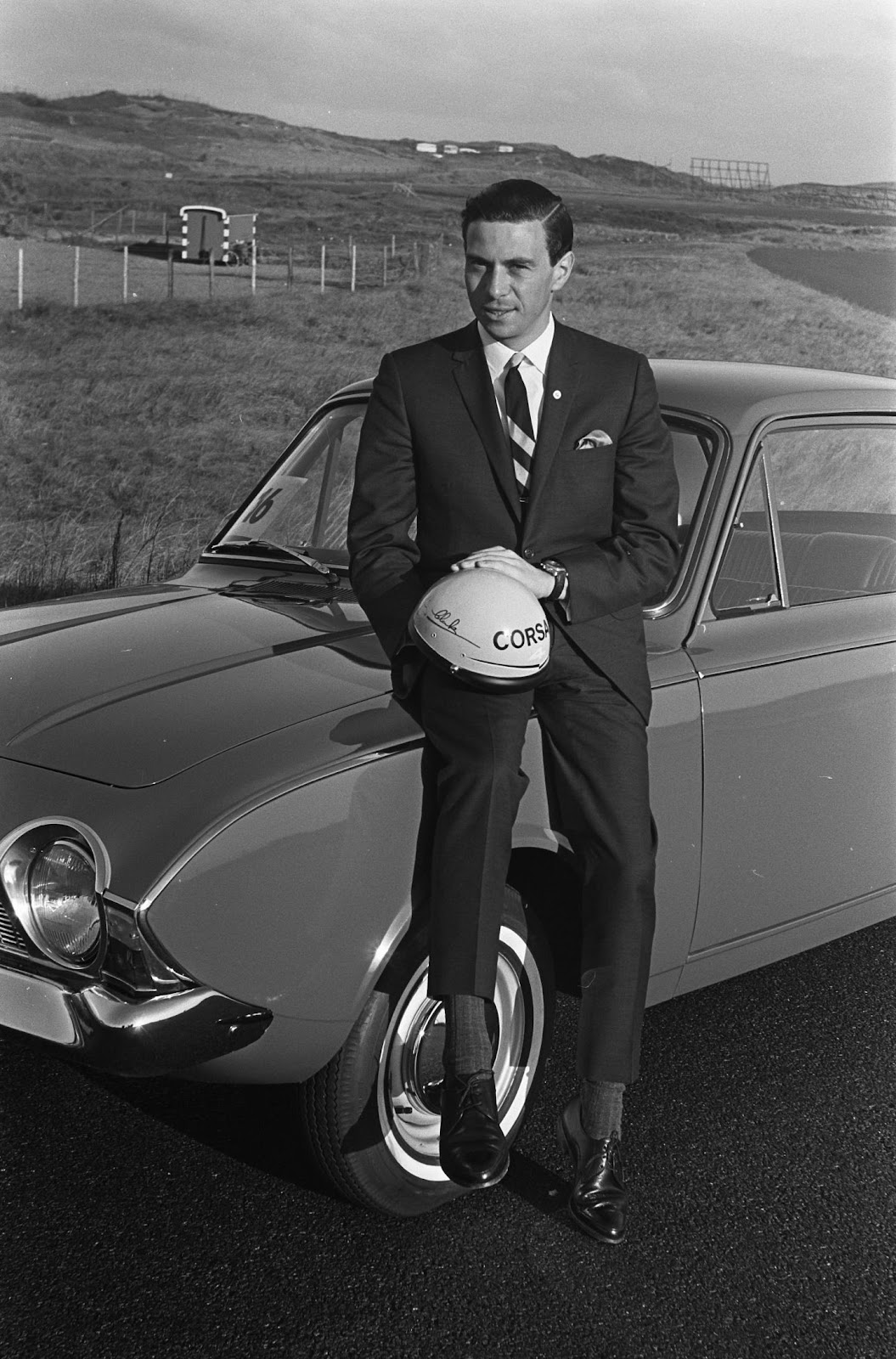
Clark was born into a farming family at Kilmany House Farm, Fife, the youngest child of five and the only boy.
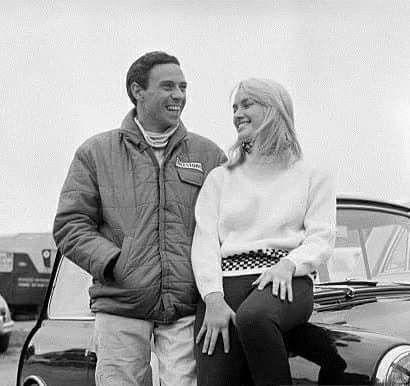
Although his parents were opposed to the idea, Jim started his racing in local road rally and hill climb events driving his own Sunbeam-Talbot and proved a fearsome competitor right from the start.
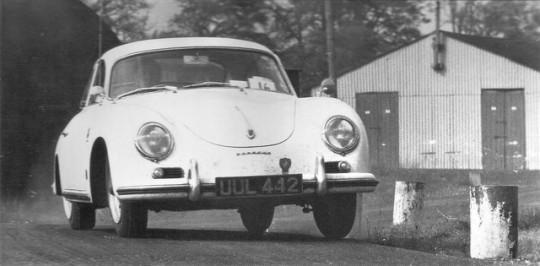
Jim Clark, Porsche 356, in 1958.
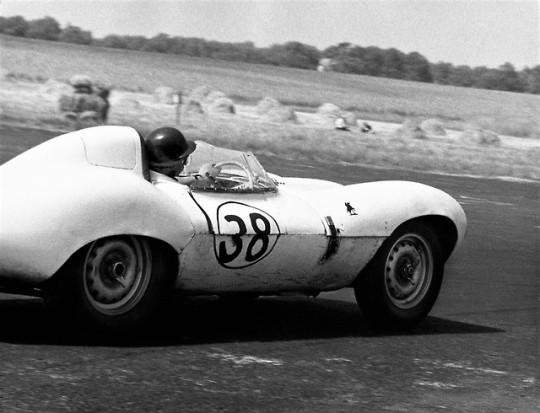
Jim Clark, Jaguar Type-D 1958.
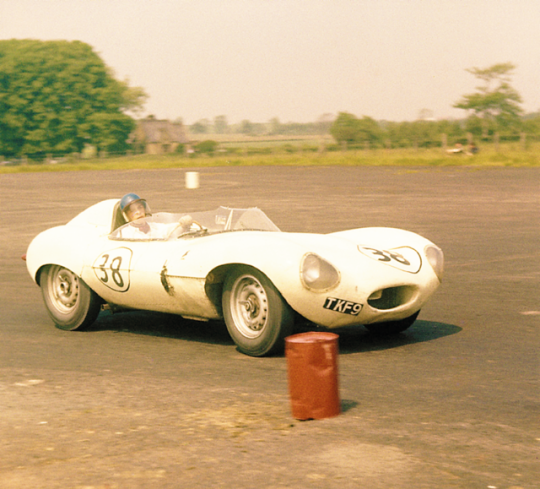
Jim Clark, Jaguar D-Type, in 1958.
Then, on Boxing Day 1958, Clark raced against the man who would launch him to superstardom. Driving a Lotus Elite, he finished second to Colin Chapman in a ten-lap GT race at Brands Hatch. In 1959 he drove a Lotus Elite, finishing tenth at Le Mans partnered with John Whitmore and the ex-Bruce Halford Lister Jaguar, winning the Bo'ness Hill Climb. Chapman was sufficiently impressed to give Clark a ride in one of his Formula Junior cars.
"In March 1960, the first race for the newly introduced Formula Junior took place at Goodwood. The winner was J. Clark (Lotus Ford), from J. Surtees (Cooper B.M.C) with T. Taylor (Lotus Ford) third."
Clark made his F1 GP debut, part-way through the season, at the Dutch GP at Zandvoort on 6 June 1960. He retired on lap 49 with final drive failure.
His second F1 race was the 1960 Belgian GP, held at the extremely fast and dangerous Spa-Francorchamps circuit; there, he got a taste of reality when two fatal accidents occurred (Chris Bristow and Alan Stacey). Clark was later quoted as saying in a 1964 interview: "I was driving scared stiff pretty much all through the race", even though he finished 5th and scored his first points finish.
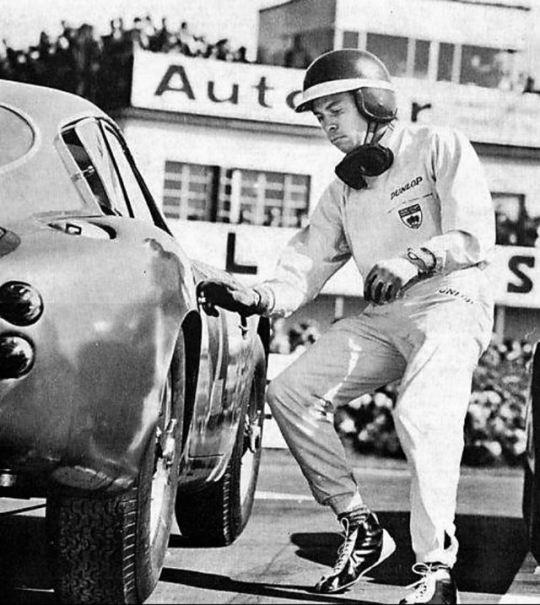
Jim Clark at the start of the TT race in 1961.
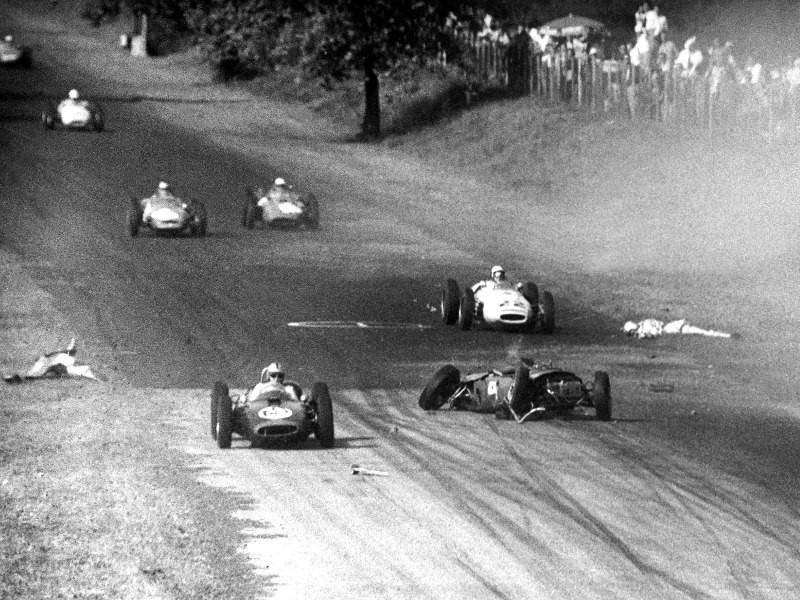
"One minute I was racing and I liked it. The next I was walking away from a horrible tangle. I didn't want to see a racing car anymore." Jim Clark, Monza 1961
The next year, the Scot was involved in one of the worst accidents in the history of F1 racing. In the 1961 Italian GP on 10 September at Monza, Wolfgang von Trips in his Ferrari collided with Clark's Lotus. Von Trips's car became airborne and crashed into a side barrier, fatally throwing von Trips out of the car and killing fifteen spectators.
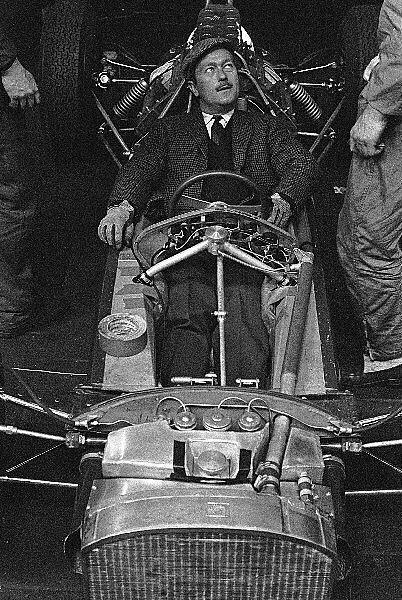
Jim Clark and Colin Chapman, Lotus 25, at the 1962 Dutch Grand Prix. Credit Getty Images, Sutton Images
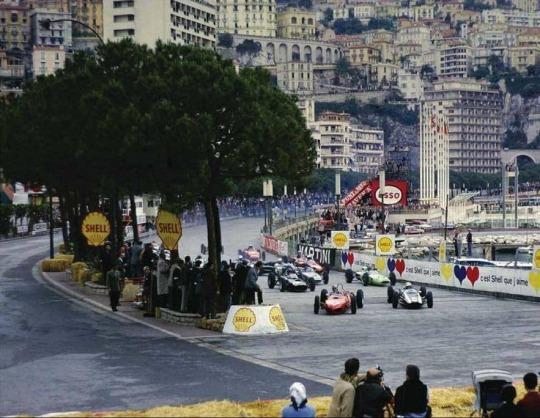
The 1962 Grand Prix at Monaco.
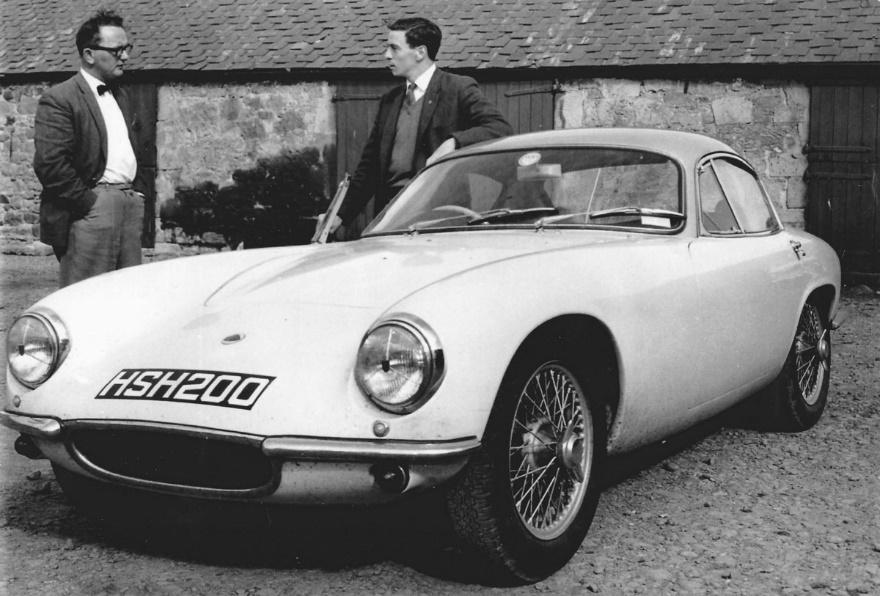
Jim Clark and James Scot in 1962 with Jim’s new Lotus Elite.
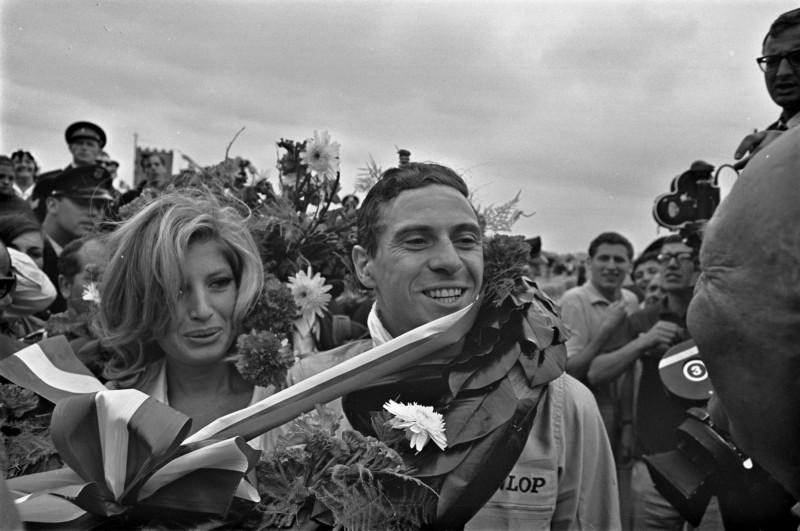

Jim Clark, Lotus Climax 25, at Zandvoort in 1963. Photo by Yves Debraine. Source: UK Racing History.
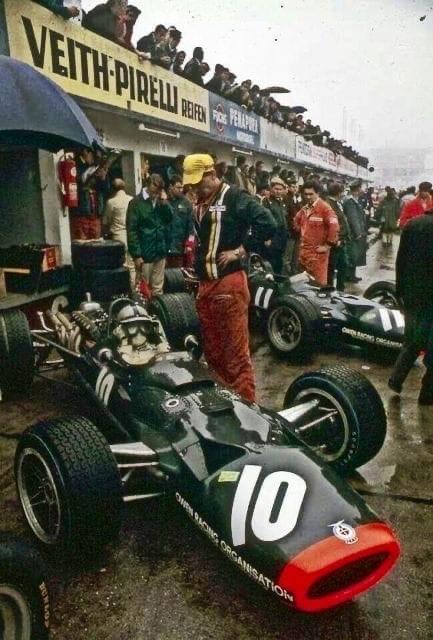
Jim Clark at Nurburgring.
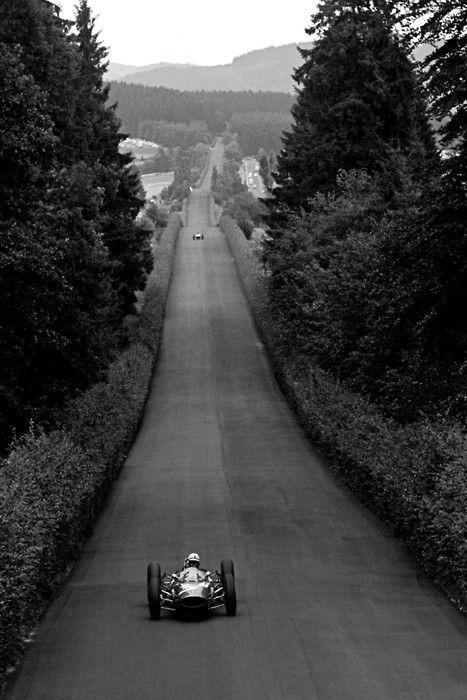
John Surtees, Ferrari and Jim Clark, Lotus at the 1963 German GP at Nurburgring.
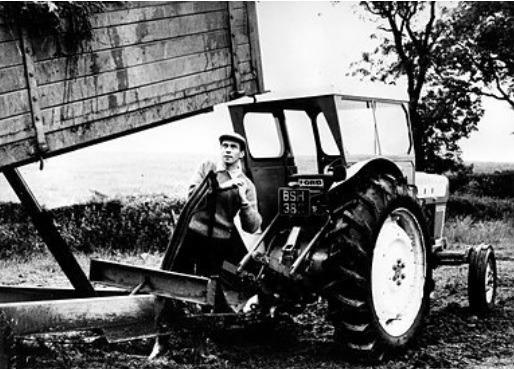
September 9th 1963 saw Jim Clark became the (then) world’s youngest F1 motor racing champion at 27 years old.
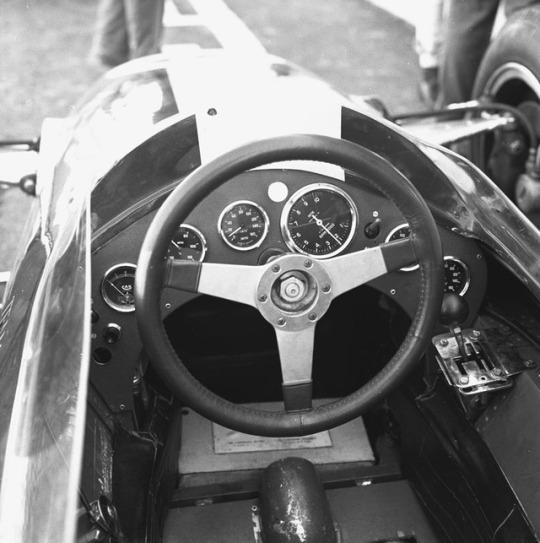
Inside Jim Clark's Lotus 25 cockpit for the 1963 Mexican Grand Prix.
His first Drivers' World Championship came driving the Lotus 25 in 1963, winning seven out of the ten races and Lotus its first Constructors' World Championship.
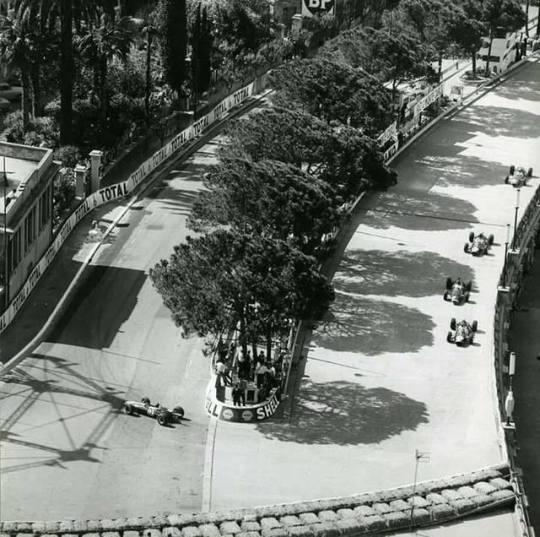
Jim Clark, Lotus-Climax 25, at the 1964 Monaco Grand Prix. Source UK Racing History.
In 1964 Clark came within just a few laps of retaining his World Championship crown but, just as in 1962, an oil leak from the engine robbed him of the title, this time conceding to John Surtees.
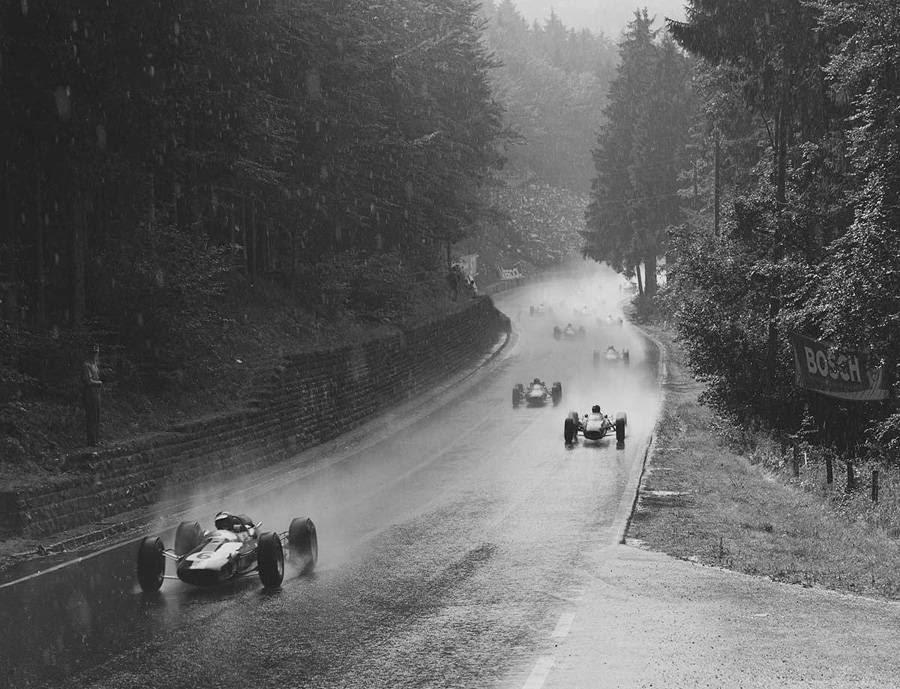
Jim Clark in action on the German circuit of Solitude in 1964 (disused after a few years). Some photos scare you just looking at them ...
Tyre failure damaging the Lotus's suspension put paid to that year's attempt at the Indianapolis 500.
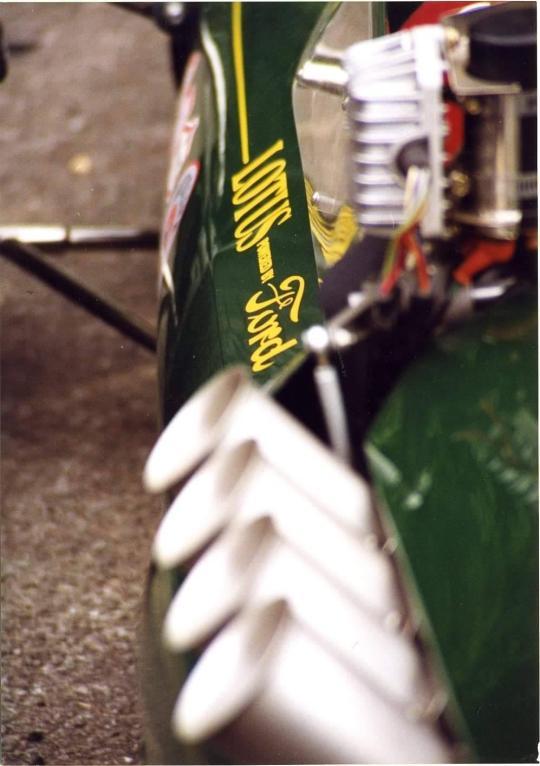
Jim Clark, Lotus-Ford 38, the winner of the 1965 ‘500 Miles of Indianapolis”. Photo by Pinterest. Source UK Racing History.
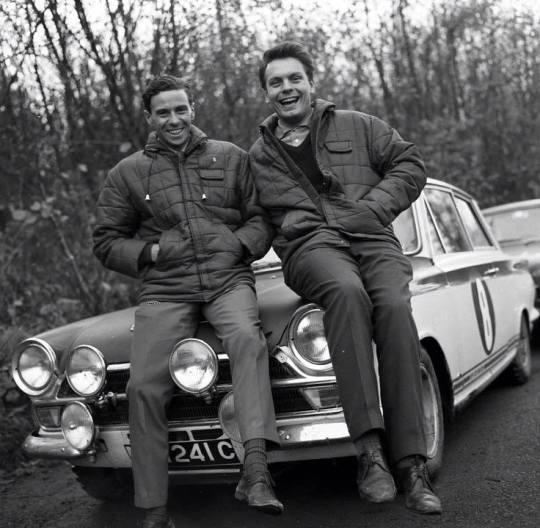
Jim Clark (F1 WC) and Roger Clark (UK Rally Champion) at Brands Hatch in 1965. Photo by Twitter. Source: UK Racing History.
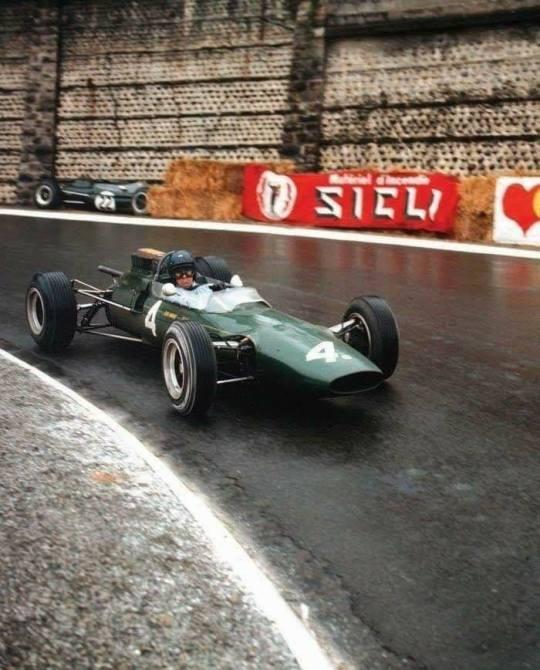
Jim Clark, Lotus-Cosworth 35, the winner of the 1965 Pau Grand Prix. Photo by LAT. Source: UK Racing History.
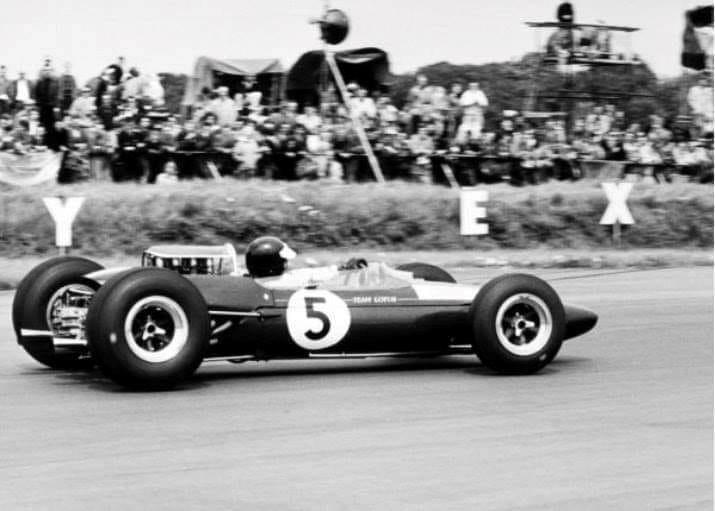
In the 1965 British Grand Prix Jim Clark is in the lead but, when there are still a quarter of the laps to go, he realizes that the oil pressure of his Lotus begins to decrease. The Scotsman then decides to tackle the right turns by switching off the engine, facing the change of direction for inertia and then re-ignite the engine on the straight. This clever and insane maneuver allows him to take victory in front of Graham Hill, with a gap of only 3 seconds. Big Jim remains one of the most phenomenal racing drivers in motorsport history.
He made amends and won the Championship again in 1965 and also the Indianapolis 500 in the Lotus 38.
He had to miss the prestigious Monaco GP in order to compete at Indianapolis, but made history by driving the first mid-engined car to win at the fabled "Brickyard," as well as becoming the only driver to date to win both the Indy 500 and the F1 title in the same year.
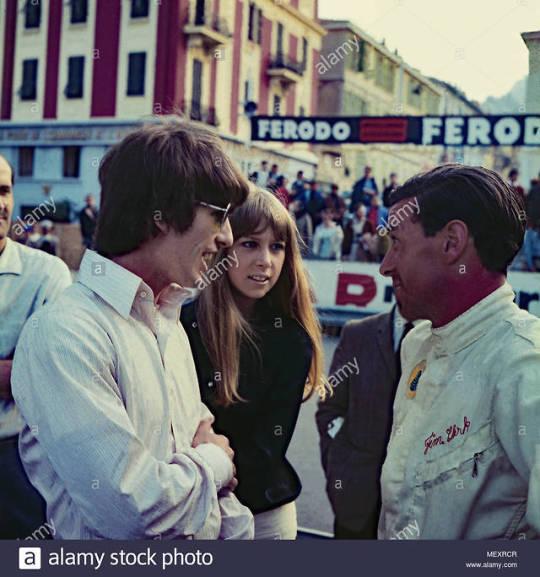
Beatle George Harrison and Patricia Anne Pattie Boyd visiting Monte Carlo and talking to F1 racing driver Jim Clark, 22nd May 1966.
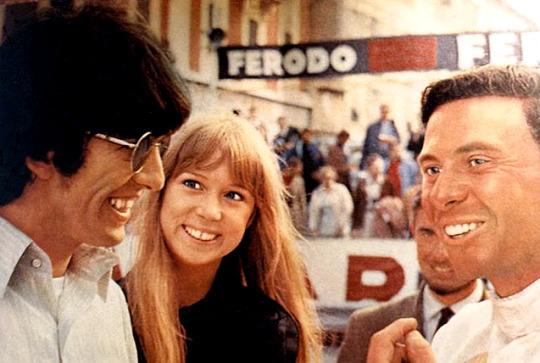
Jim Clark, George Harrison and Patty Boyd on May 22nd at the 1966 Monaco Grand Prix.
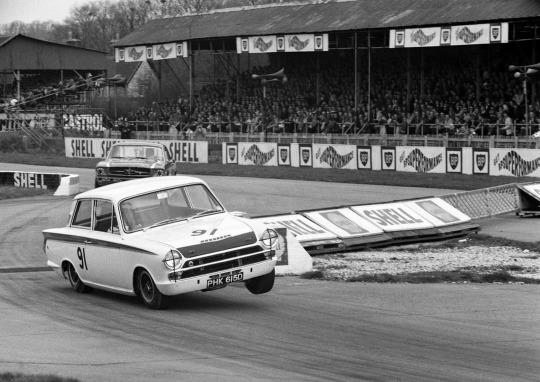
Jim Clark, Ford Lotus Cortina, ahead of Jack Brabham, Alan Brown Ford Mustang, at the 1966 St Mary's Trophy in Goodwood. Photo by Pinterest. Source: UK Racing History.
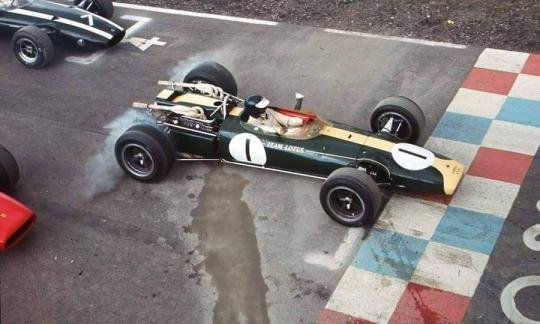
Jim Clark, Lotus-BRM 43 H16, winner of the USA Grand Prix at Watkins Glen in 1966. Source: UK Racing History.
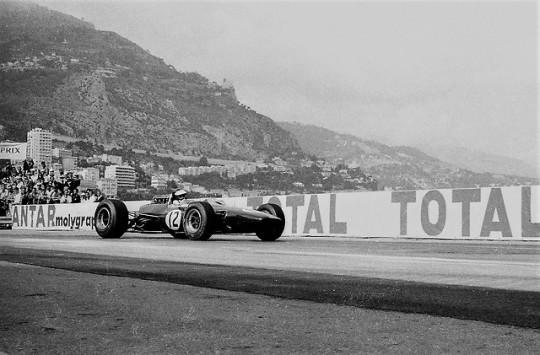
Jim Clark, Lotus 33 Climax, at the 1967 Monaco Grand Prix.
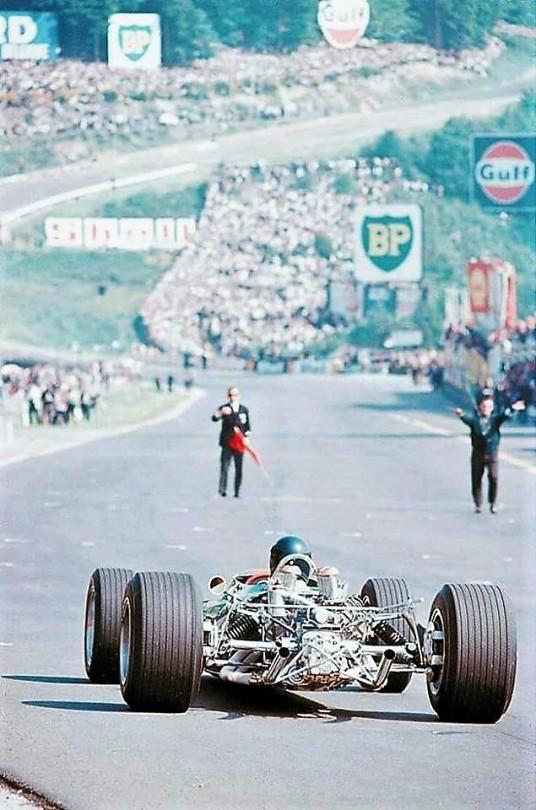
Jim Clark, Lotus-Ford 49, at the 1967 Belgian Grand Prix in Spa-Francorchamps. Source: UK Racing History.
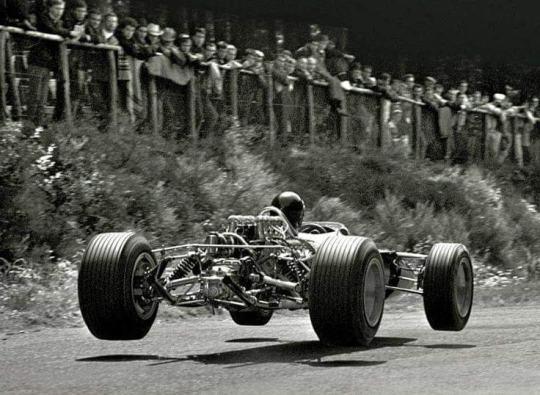
Jim Clark, Lotus-Ford 49, at the 1967 German Grand Prix in Nürburgring. Source: UK Racing History.
During 1967 Lotus and Clark used three completely different cars and engines. The Lotus 43 performed poorly at the opening South African GP, so Clark used an old Lotus 33 at the following Monaco GP, retiring with suspension failure. Lotus then began its fruitful association with Ford-Cosworth. Their first car, the Lotus 49 featuring the most successful F1 engine in history, the Ford-Cosworth DFV, won its first race at the Dutch GP, driven by Clark.
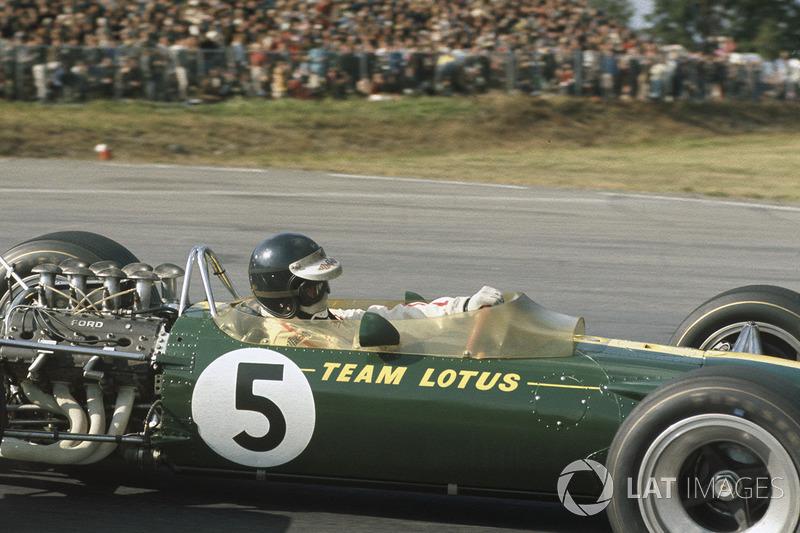
F1 United States Grand Prix 1967, Jim Clark in a Lotus 49.

Jim Clark, Lotus 49 Ford Cosworth, Grand Prix of Mexico, Autodromo Hermanos Rodriguez, 22 October 1967. Photo by Bernard Cahier/Getty Images.
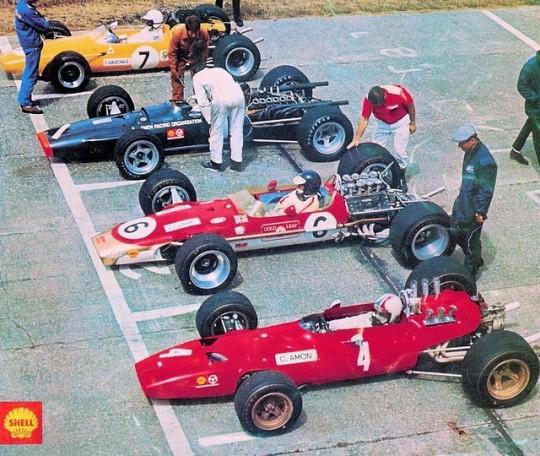
Jim Clark and Chris Amon in 1968.
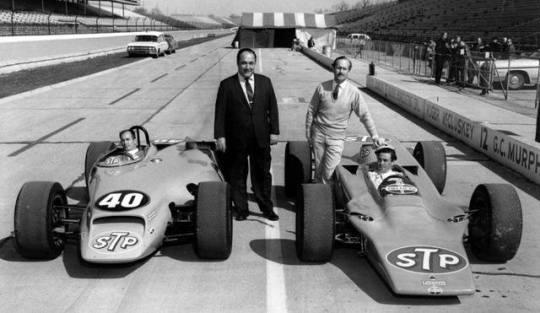
Parnelli Jones and Jim Clark, Pratt & Whitney turbine Lotus, with Andy Granatelli and Colin Chapman at the 1968 “Indianapolis 500 Miles” tests. UK Racing History.
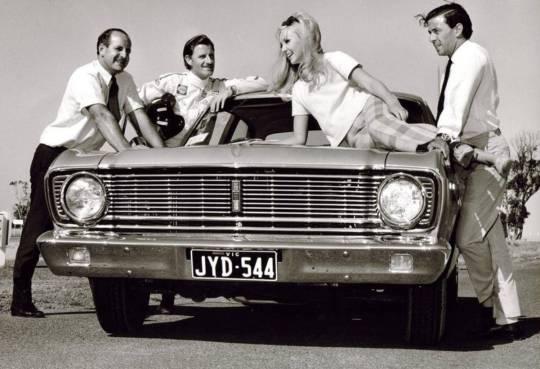
A blondie top model surrounded by champions Denny Hulme, Graham Hill and Jim Clark at Melbourne in 1968. Photo by Promotipo. Source: UK Racing History.
He won with it again at the British, United States and Mexican GP; and, in January 1968, at the South African GP.
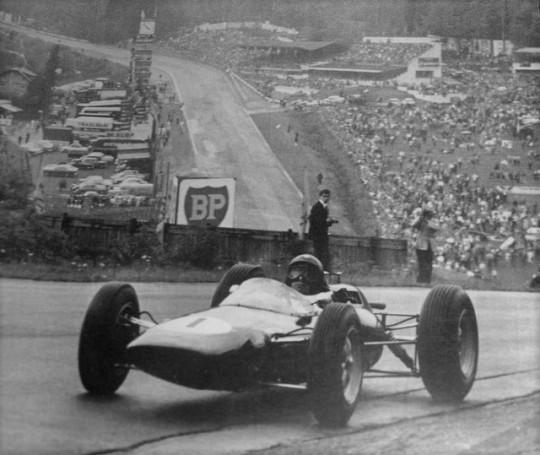
Jim Clark at Spa.
Clark won the 1963 Belgian GP at Spa-Francorchamps in extremely foggy and rainy conditions. After starting eighth on the grid he passed all of the cars in front of him, including early leader Graham Hill. About 17 laps into the race, with the rain coming down harder than ever, Clark had not only lapped the entire field except for Bruce McLaren, but he was almost five minutes ahead of McLaren and his Cooper. This would be the first of seven victories for Clark and Team Lotus that year.
In the 1967 Italian GP at Monza, after starting from pole, Clark was leading in his Lotus 49 (chassis R2), when a tyre punctured. He lost an entire lap while having the wheel changed in the pits. Rejoining sixteenth, Jim ripped back through the field, progressively lowering the lap record and eventually equalling his pole time of 1m 28.5s, to regain the lost lap and the lead. He was narrowly ahead of Brabham and Surtees starting the last lap, but his car had not been filled with enough fuel for such a performance: it faltered and finally coasted across the finish line in third place.
In his Indianapolis 500 win, Clark led for 190 of the 200 laps, with an unprecedented average speed of over 150mph (240 km/h), to become the first non-American in almost half a century to win the famous race.

On 7 April 1968, he died in a racing accident in West Germany. During the 4-month gap between the first (which Clark won) and second race of the 1968 F1 season, drivers would compete in other racing formulas. Clark chose to drive, in the Deutschland Trophäe, a Formula 2 for Lotus at the Hockenheimring, primarily due to contractual obligations with Firestone. Although the race has sometimes been characterised as a "minor race meeting", the entry list was impressive with top-running Matras for the French drivers Jean-Pierre Beltoise and Henri Pescarolo, Tecnos for Carlo Facetti and Clay Regazzoni, Team Brabhams for Derek Bell and Piers Courage, a Ferrari for Chris Amon and McLarens for Graeme Lawrence and Robin Widdows. Team Lotus drivers Graham Hill and Clark were in Gold Leaf Team Lotuses and a young Max Mosley was also in the race, moving up from the Clubman series. The event was run in two heats. On the fifth lap of the first heat, Clark's Lotus 48 veered off the track and crashed into the trees. He suffered a broken neck and skull fracture and died before reaching the hospital. The cause of the crash was never definitively identified, but investigators concluded it was most likely due to a deflating rear tyre.
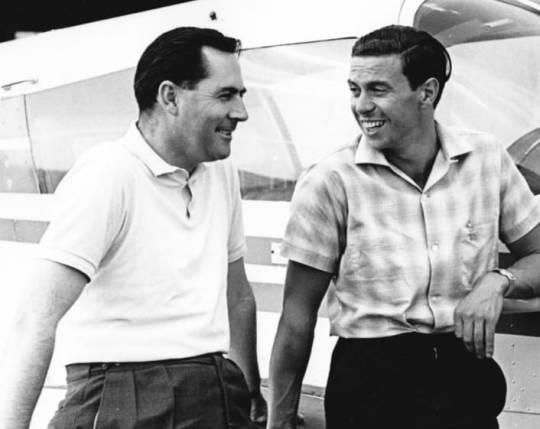
Jack Brabham and Jim Clark. Photo by Windsor Collection. Source UK Racing History.
Clark's death affected the racing community terribly, with fellow F1 drivers and close friends Graham Hill, Jackie Stewart, Dan Gurney, John Surtees, Chris Amon and Jack Brabham all being personally affected by the tragedy. People came from all over the world to Clark's funeral. Colin Chapman was devastated and publicly stated that he had lost his best friend. The 1968 F1 Drivers' Championship was subsequently won by his Lotus teammate Graham Hill, who pulled the heartbroken team together and held off Jackie Stewart for the crown, which he later dedicated to Jim.

Jim Clark memorial at Hockenheimring.
There is a large memorial to Clark at Hockenheim today but, because the track has been reduced in length and the old course reforested, the actual location of the crash is in a heavily wooded area; it is however easily accessible.
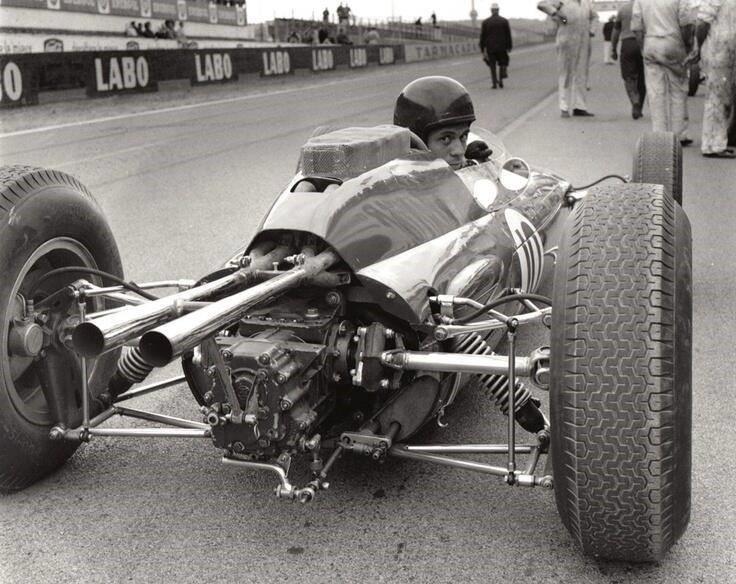
Impossible to think of Hockenheim without thinking of that crash into the trees, of his Lotus over the guard rail at more than 240 kilometers per hour. A life that broke apart at the age of 32 ... becoming a legend. Anyone who has seen Jim Clark racing knows well that before him there was Juan Manuel Fangio and after him came Jackie Stewart, Alain Prost, Ayrton Senna, Michael Schumacher and Lewis Hamilton. But only in chronological order because, even though he became world champion only twice, Clark was perhaps the best of all.
Jim Clark and English fashion model Jean Shrimpton in an advertising image for the Ford Corsair, United Kingdom, 1965-66. Photograph by David Bailey.

Jean Shrimpton, the beautiful model emblem of the English 60s. Her photographs as well as the deeds of Jim Clark and the beauty of Lotus remain the pillars of that magical period.
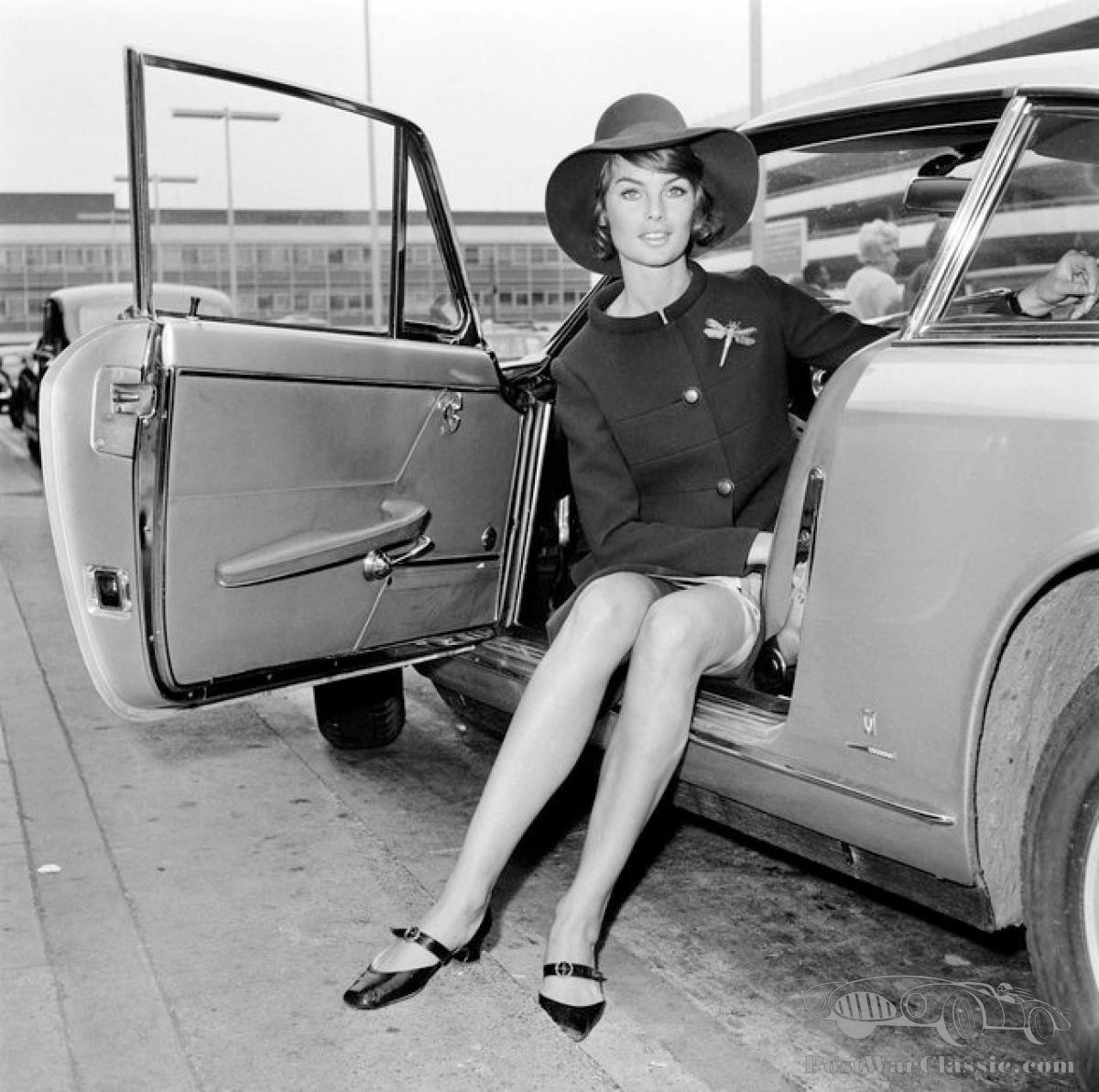



Photo by The Duffy Archive LTD.







Jim Clark: a one-of-a-kind driver. Fifty years after his tragic death, Peter Collins reveals some characteristics of one of the strongest Formula 1 drivers ever. Published on May 18, 2018.
Jim Clark was one of the most popular drivers in Formula 1 history. Winner of two world titles in 1963 and 1965, he has respectable numbers on his side: 25 wins, 32 podiums, 33 pole positions and 28 fastest laps. He was defined by Juan Manuel Fangio as "the best driver of all time" and, as many colleagues of the time recall, he had some peculiar characteristics that made him special. As Jack Brabham explained, Clark before each race was very tense: “he was a bundle of nerves before the races … if you went to pat him on the back he would get so scared. And, of course, it didn't help. We had a doctor in Munich who checked the blood pressure and he didn't want to let him start. But, once the race started, it was a whole other story!" One of the main characteristics of him was, in fact, the ability to know how to start very well, creating a gap with the opponents in the first laps. The secret was to take a look at the colleagues behind him and then, as he loved to repeat, "go madder than ever and go!" As he himself wrote in his biography “Jim Clark at the wheel”, "the supreme attraction of motoring for me is driving the car as close as possible to the physical limit without exceeding it. I have always recognized and respected the safety limits for myself and the other drivers and I would rather lose a race than go beyond my limits or those of my car." However, in Clark's thought there was also room for fear, one of the most basic emotions in life: "it's all part of fear. If there is nothing to be afraid of, any dummy could get into the cockpit. I think about the danger, from time to time, especially when there are many trees“. And it was a tree, by a tragic twist of fate, that put an end to the life of the flying Scotsman, in a controversial accident whose dynamics have not yet been fully defined. But, for the Scotsman, motorsport was an extraordinary thing, comparable to another great human activity: "a man who has innate abilities goes further than someone who hasn't. He is like an artist who can paint on a canvas and create a picture… most of us would just make a mess. That's why I consider car racing an art".
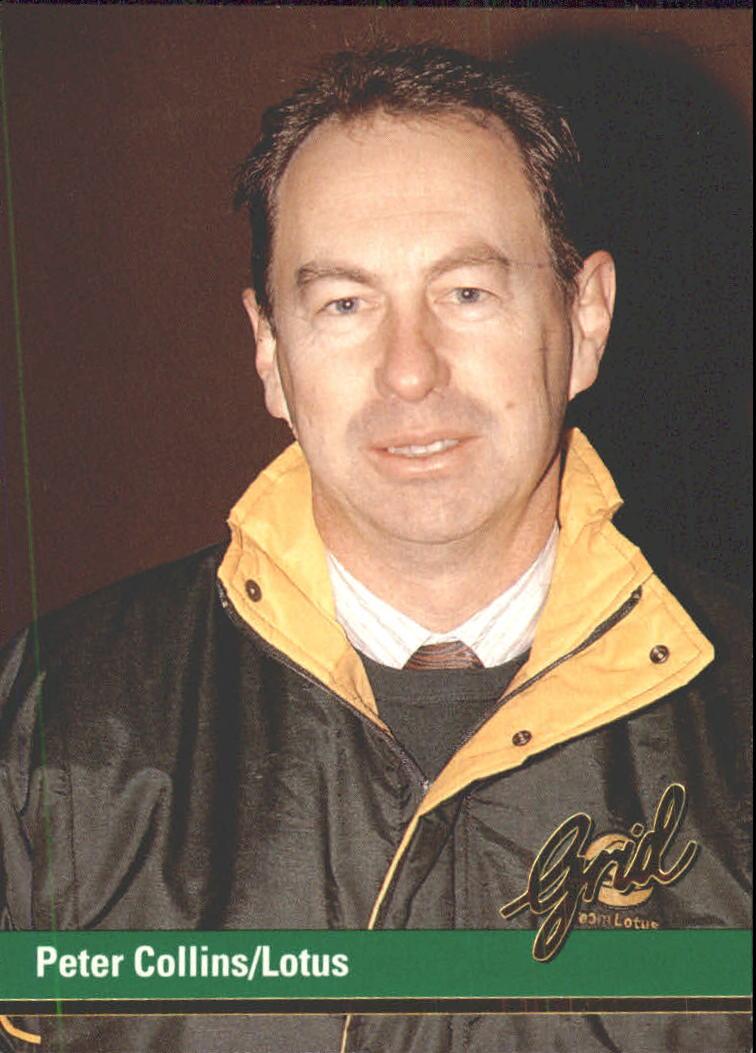
As Peter Collins, former team manager of Lotus and Williams, explains, Clark had a particular driving style, which allowed him to transform understeer (traditionally considered a disadvantage in racing cars) into an advantage, especially on a technical and difficult track like the old Nurburgring: “to counterbalance the understeer, he gave a resolute turn of the steering wheel that seemed to destabilize the rear, but the change of direction of the weight of the rear affected the behavior of the car. Thus the car was placed on a trajectory that led to the line and position at the exit from the desired curve: when the mass of the car was moved the car returned to its usual behavior and this allowed him to push hard on the accelerator, entering corners at a higher speed while maintaining a higher speed. Understeer allowed him to open the throttle ahead of his opponents without fear of power oversteers. He knew how to drive an understeering car that slipped and how to perfectly judge the exit point from the corner. He also patted the brake in the middle of the hairpin bends, which is thought to be used to move the rear to direct the car in the best possible way. The partialization of the throttle was not as aggressive as that of [Keke] Rosberg or Ayrton Senna, but it was certainly part of his tricks." However, it wasn't just these gimmicks that made his mastery special: “his driving was incredibly smooth in the highlights. Looking at the first parts of various races, one gets the impression that he was mentally stronger in the car than his rivals. During the competition at the 'Ring' in 1967, it is impressive to see that there were no interruptions in the transition between braking, cornering and subsequent acceleration: these are small details compared to Dan Gurney and Denny Hulme, almost imperceptible: however they made a difference on a car that, from the beginning, had tires that were slowly deflating. The more you watch the videos, the more discipline and consistency (corner entry, apex, exit point) become evident, along with their meaning and value. His lines were more efficient, the entry lines shallower and narrower and there was more rotation. Gurney and Hulme weren't all that precise or consistent with their lines, nor were Surtees, Gurney and Hill in 1964. Jimmy's disciplined driving most likely played an important role in his performance - the more you do the same thing, the more habitual and repeatable it becomes ... this is a big problem today with young drivers. Discipline is something that is acquired as we grow up and it is likely that the demands of Jim's early farming life instilled in him a natural sense of discipline”. The peculiarities of Clark, however, are not limited to this, because the flying Scotsman has gone down in history also thanks to his lightning fast starts and his very consistent first laps, through which he put between himself and his rivals a gap that was difficult to bridge, as Collins further explains: “his starts were almost always exceptional. Looking at the start of various German Grands Prix, where the line of the top four cars always provides a good viewing angle to make a comparison, one can think that he had a lower first gear than most of his peers, or that he was a lot faster in shifting up gears, as he gained several meters while the others began to move. He almost always warmed up the rear tires and never seemed to try to limit wheel slip. Aside from the incredible starts, his first laps were so impressive. His first corner entry speed was visibly higher [than the others], which demonstrated tremendous self-confidence and an incredible awareness of the absolute limit of grip available at the time, while others were still finding them. This is particularly relevant when you consider that the tires were cold at the first corner. Somehow, he must have been able to get a certain perception of the grip available, both visually, by measuring the traction from the starting grid and in some other way. Whatever it was, he obviously processed all the information very quickly and, therefore, relied on his judgment." As has been done by many other insiders, Peter Collins also praises the flying Scotsman beyond his specific abilities or his tricks: “Jimmy was an absolute artist and a marvel to behold. The voice of the Nurburgring GP commentator and his reaction to Jim's speed at the Brunnchen corner, in a particular video, makes it clear. Nobody compares drivers as "complete packages", but they should: Jim had a driving like velvety, silky, linear ... it was like watching a ballerina dance, he made driving a racing car an art, I've never seen anyone better than him on the track“.
Lotus
Lotus has gone through different times and has marked their history. A revolutionary car that embodied the typical English style. A hymn to lightness. Colin Chapman, its ingenious inventor, said: "adding power you go faster on the straight, subtracting weight you go faster everywhere."
The distance between the Chapman's Lotus - among the most beautiful and fascinating cars ever seen in Formula 1 and in general between sports and non-sports cars - and an electric SUV produced in China is that from Earth to the Moon. But, beyond the thrill of melancholy that runs down the spine of those who have seen those cars racing or simply on television, the true conquest of Lotus remains: having shown us the difference, its existence. With the outline of the beautiful world, the good times that it made us live. Lotus was a cry of freedom, the fresco of a wonderful time. And it was driven by the best ones, Jim Clark and Ayrton Senna who, like Chapman, the electric SUV will never see. For them, just like all of us, Lotus is and will remain the one that they were driving.
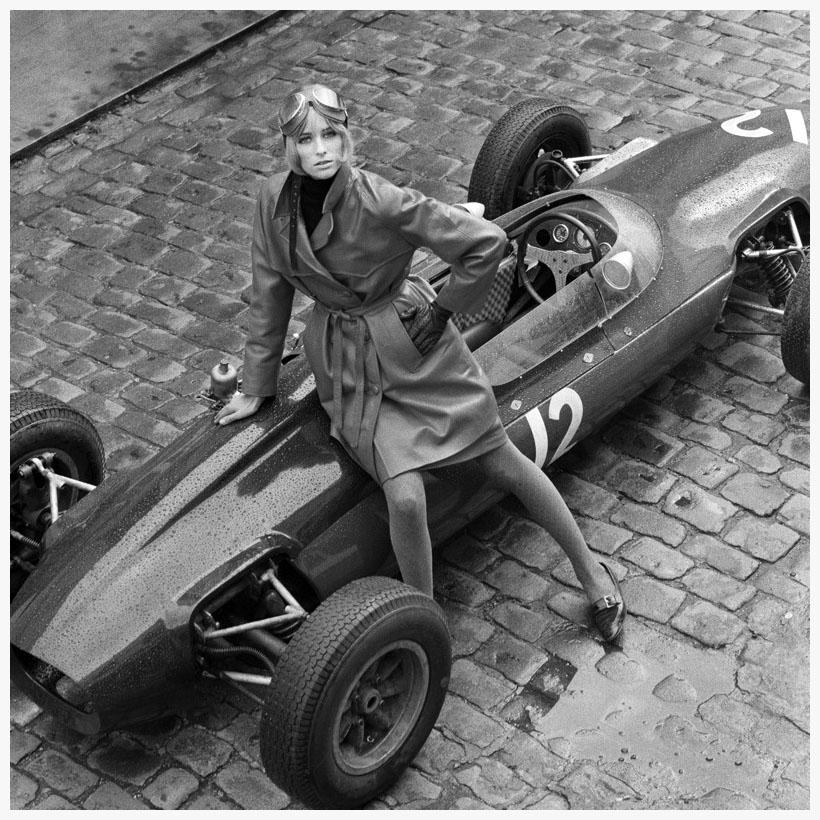
Jill Kennington Lotus F1, 1964, London. Photo by Patrick Lichfield.
Lotus Cars Limited is a British automotive company headquartered in Hethel, Norfolk, that manufactures sports cars and racing cars noted for their light weight and fine handling characteristics.
Lotus was previously involved in F1 racing, via Team Lotus, winning the F1 World Championship seven times.
Lotus Cars was founded and owned for many years by Colin Chapman. After his death and a period of financial instability, it was bought by General Motors, then Romano Artioli and DRB-HICOM through its subsidiary Proton. It is currently owned by Chinese multinational Geely.
The engineering consultancy firm Lotus Engineering, an offshoot of Lotus Cars, has facilities in the United Kingdom, United States, China and Malaysia.
The company was formed as Lotus Engineering Ltd. by engineers Colin Chapman and Colin Dare, both graduates of University College, London, in 1952, but had earlier origins in 1948 when Chapman built his first racing car in a garage. The four letters in the middle of the logo stand for the initials of company founder, Anthony Colin Bruce Chapman. When the logo was created, Colin Chapman's original partners Michael and Nigel Allen were led to believe that the letters stood for Colin Chapman and the Allen Brothers.
The first factory was situated in old stables behind the Railway Hotel in Hornsey, North London. Team Lotus, which was split off from Lotus Engineering in 1954, was active and competitive in F1 racing from 1958 to 1994. The Lotus Group of Companies was formed in 1959. This was made up of Lotus Cars Limited and Lotus Components Limited, which focused on road cars and customer competition car production, respectively. Lotus Components Limited became Lotus Racing Limited in 1971 but the newly renamed entity ceased operation in the same year.
The company moved to a purpose built factory at Cheshunt in 1959 and, since 1966, has occupied a modern factory and road test facility at Hethel, near Wymondham in Norfolk. The site is a former World War II airfield, RAF Hethel and the test track uses sections of the old runway.
In its early days, Lotus sold cars aimed at privateer racers and trialists. Its early road cars could be bought as kits, in order to save on purchase tax. The kit car era ended in the late 1960s and early 1970s, the Lotus Elan Plus Two being the first Lotus road car not to be offered in kit form and the Lotus Eclat and Lotus Elite of the mid-1970s being offered only in factory built versions.
After the elegant but delicate Lotus Elite of the 1950s, which featured a complete fibreglass monocoque fitted with built-in steel pickup points for mounting major components, Lotus found critical and sales success in the 1960s with the Lotus Elan two seater later developed to two plus two form. Lotus was notable for its use of fibreglass bodies, backbone chassis and overhead camshaft engines, initially supplied by Coventry Climax but later replaced by Lotus-Ford units (Ford block, Lotus head and twin cam valve gear). Lotus worked with Ford on the Lotus Cortina, a successful sports saloon.
Another Lotus of the late 1960s and early 1970s was the two seater Lotus Europa, initially intended only for the European market, which paired a backbone chassis and lightweight body with a mid mounted Renault engine, later upgraded to the Lotus-Ford twin cam unit as used in the Elan.
The Lotus Seven - originating in the 1950s as a simple, lightweight, open two seater - continued in production into the early 70s. Lotus then sold the rights to produce the Seven to Caterham, which has continued to produce the car since then.
By the mid-1970s, Lotus sought to move upmarket with the launch of the Elite and Eclat models, four seaters aimed at prosperous buyers, with features such as optional air conditioning and optional automatic transmissions. The mid engined line continued with the Lotus Esprit, which was to prove one of the company's longest lived and most iconic models. Lotus developed its own series of four cylinder DOHC engines, the Lotus 900 series and later a V8 and turbocharged versions of the engines appeared in the Esprit.
Variants of the 900 series engine were supplied for the Jensen Healey sports car and the Sunbeam Lotus "hot hatchback". In the 1980s, Lotus collaborated with Vauxhall Motors to produce the Lotus Carlton, the fastest roadgoing Vauxhall car.
By 1980, Group Lotus was in serious financial trouble. Production had dropped from 1.200 units per year to a mere 383. The combined reasons were that the world was in the middle of an economic recession, sales in the key United States market had virtually collapsed and there had been limited development of the then model range.
In early 1982, Chapman came to an agreement with Toyota to exchange intellectual property and applied expertise. This initially resulted in Lotus Engineering helping to develop the Mk2 Toyota Supra, also known as the Toyota Celica XX. Secondly, it allowed Lotus to launch the new Lotus Excel to replace the ageing Lotus Eclat. Using drivetrain and other components from Toyota enabled Lotus to sell the Excel for £1,109 less than the outgoing Eclat.
Looking to re-enter the North American market, Chapman was approached by young law professor and investment banking consultant, Joe Bianco, who proposed a new and separate United States sales company for Lotus. By creating an unprecedented tax-incentived mechanism wherein each investor received a specially personalised Lotus Turbo Esprit, the new American company, Lotus Performance Cars Inc. (LPCI), was able to provide fresh capital to the Group Lotus in the United Kingdom. Former Ferrari North America general manager John Spiech was brought in to run LPCI, which imported the remarkable Giugiaro-designed Turbo Esprit for the first time. US sales began to quickly jump into triple digits annually.
Chapman died of a heart attack on 16 December 1982, at the age of 54, having begun life an innkeeper's son and ended a multi-millionaire industrialist in post-war Britain.
On 24 May 2017, Chinese multinational Geely announced that was taking a 51% controlling stake in Lotus. The remaining 49% were acquired by Etika Automotive.
In its early days, the company encouraged its customers to race its cars and it first entered F1 through its sister company Team Lotus in 1958. A Lotus F1 car driven by Stirling Moss won the marque's first GP in 1960 at Monaco. Moss drove a Lotus 18 entered by privateer Rob Walker. Major success came in 1963 with the Lotus 25, which – with Jim Clark driving – won Team Lotus its first F1 World Constructors Championship. Clark's untimely death – he crashed a Formula 2 Lotus 48 in April 1968 – was a severe blow to the team and to F1. He was the dominant driver in the dominant car and remains an inseparable part of Lotus's early years.
Team Lotus was among the pioneers in F1 in adding wings and shaping the undersurface of the car to create downforce, as well as the first to move radiators to the sides of the car to aid in aerodynamic performance and inventing active suspension.
Even after Chapman's death, until the late 1980s, Team Lotus continued to be a major player in F1. Ayrton Senna drove for the team from 1985 to 1987, winning twice in each year and achieving 17 pole positions. By the company's last F1 race in 1994, the cars were no longer competitive. Team Lotus constructed cars won a total of 79 GP races.
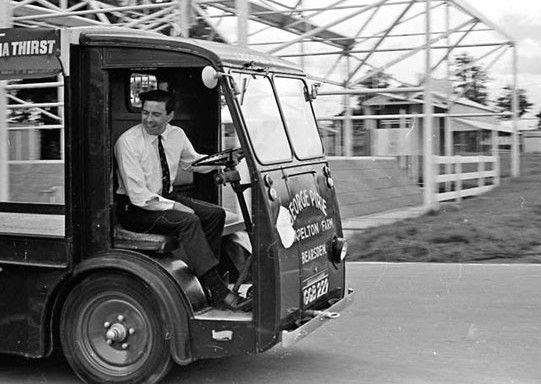
Clark was a modern race driver who took advantage of the many PR opportunities offered to him. That is to say money of course. But he also put up money to enable Scotchcircuits Ltd. to open a new race track near Edinburgh and took part in an impromptu race of electric milk vans. He obviously enjoyed that, too. July the 10th 1965.
F1 Drivers' Championship winner for Lotus were Jim Clark in 1963 and 1965, Graham Hill in 1968, Jochen Rindt in 1970, Emerson Fittipaldi in 1972 and Mario Andretti in 1978. In 1973 Lotus won the constructors' championship only.
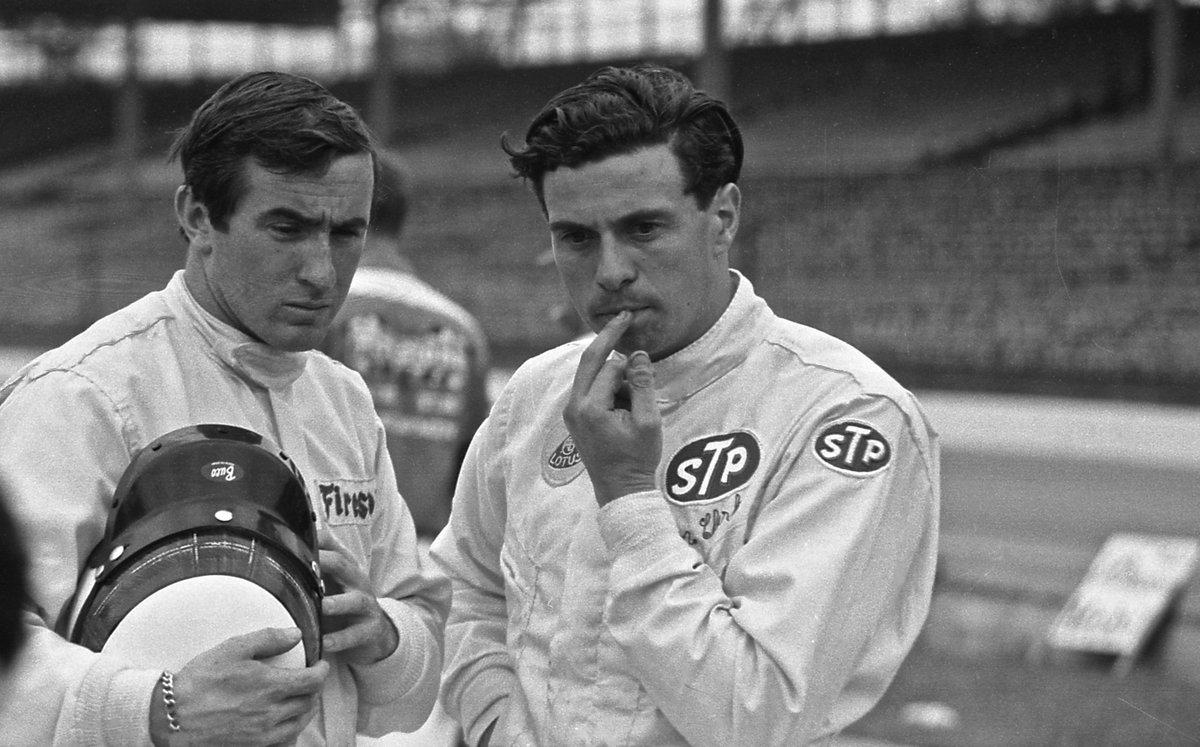
The drivers' title went to Jackie Stewart of Tyrrell.
Team Lotus established Classic Team Lotus in 1992, as the Works historic motorsport activity. Classic Team Lotus continues to maintain Lotus F1 cars and run them in the FIA Historic F1 Championship and it preserves the Team Lotus archive and Works Collection of cars, under the management of Colin Chapman's son, Clive.
The Lotus name returned to F1 for the 2010 season, when a new Malaysian team called Lotus Racing was awarded an entry.
Lotus 25 1964
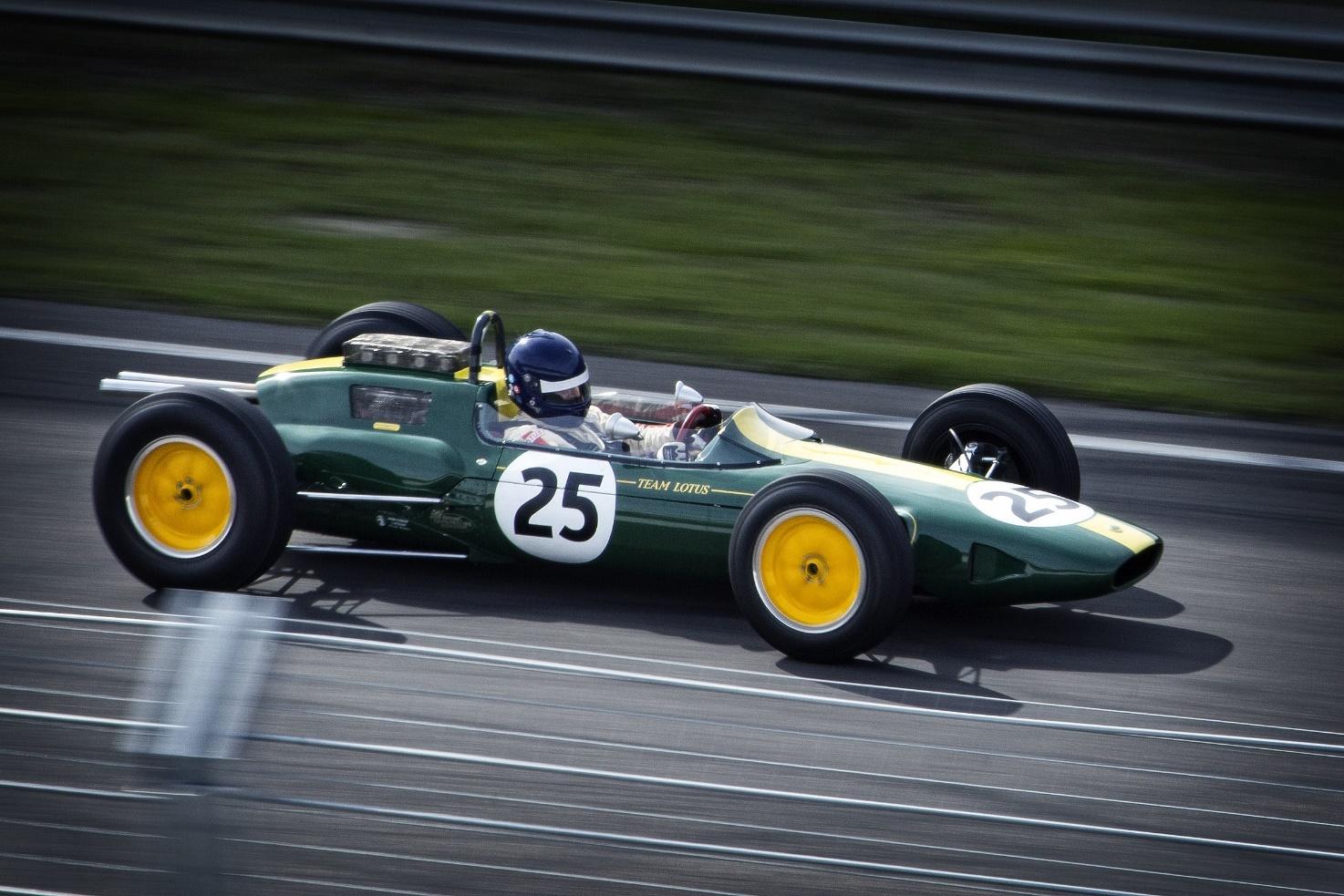
Lotus 49 1968
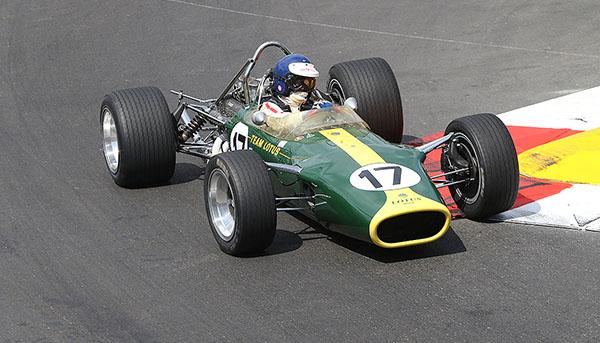
Lotus 49B 1969
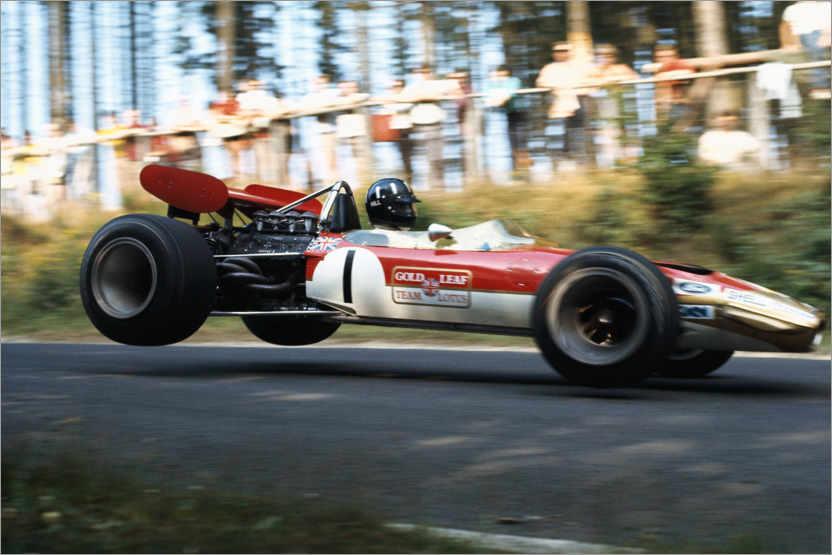
Lotus 1972 72D

Lotus 1973
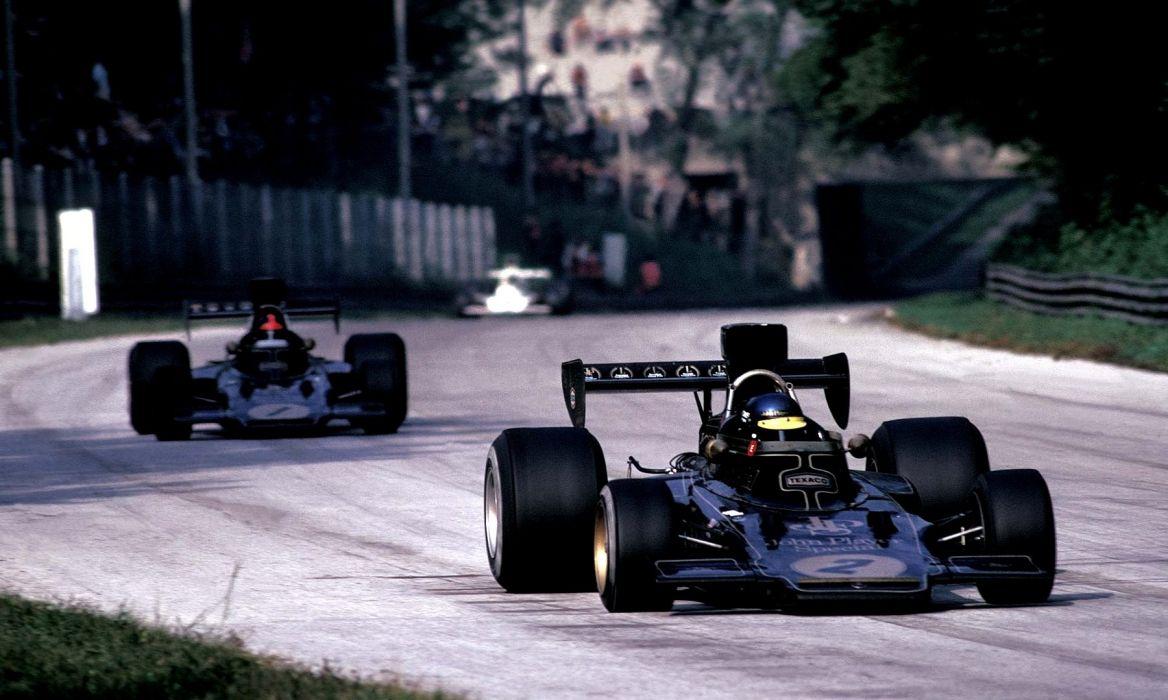

Lotus 1976 Type 77

Lotus 1977 Type 78

Lotus 1978 Type 79

Maximum down force minimum drag: Clive Chapman, son of Lotus founder, the late Colin, describes how a chance discovery changed F1 forever. Featuring the Type 78, the title winning Type 79. Mario Andretti won the F1 title in the Type 79 and, the first time he drove it, described that car like “being painted to the track.”
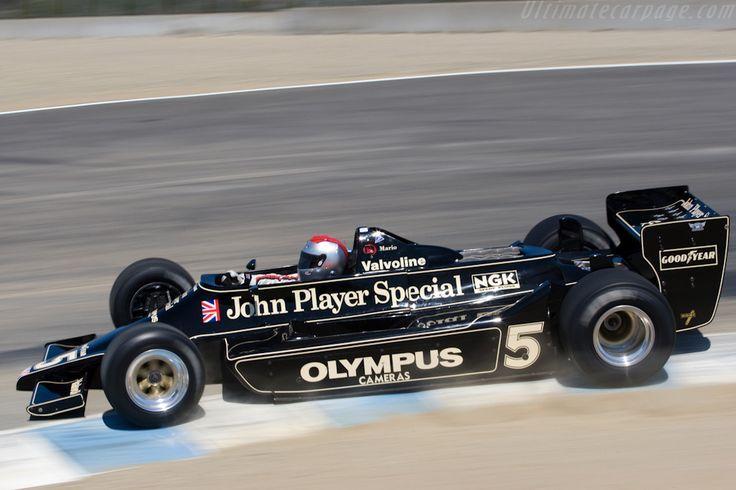
The Type 79, the “Black Beauty”, is perhaps the most beautiful and certainly the most innovative F1 car in history. With its ground effect it has led its opponents to be content with just seeing its rear wing up close. Overtaking it, well, a completely different story... It won by knockout.
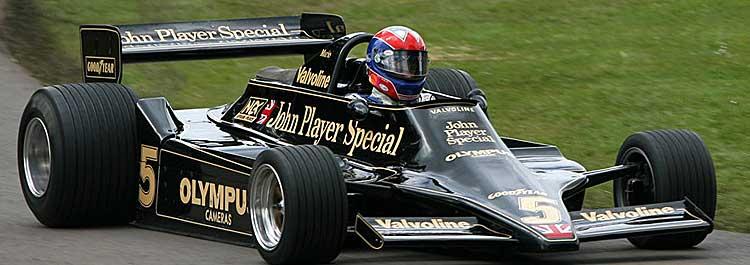
Clive Chapman said about this car: “Type 79 was a fantastic car, it looked beautiful. Quick in qualifying, my father was telling mechanics to put more fuel in the car. The 79 just represented victory. Everybody loved the Black Beauties finishing in first and second place, which was quite unusual in those days. More than anything it was just that phenomenal speed in the corners. 2 seconds a lap faster than the 78 of the previous year. It’s hard to find a better Formula 1 car than this.”
Gian Paolo Dallara said about Colin Chapman: “when Chapman made the carrier engine... He was a genius. He won less than Forghieri. Forghieri did other things, Mauro was more complete but Colin was more brilliant. Better than the others. There was always something to learn. He was the first to use miniskirts.”
-
Lotus 12 (1956–1957): Formula Two and Formula One racecar
-
Lotus 16 (1958–1959): F1/F2 car, "Miniature Vanwall"
-
Lotus 18 (1960–1961): First mid-engined Lotus single seater—Formula Junior/F2/F1
-
Lotus 21 (1961): Formula One
-
Lotus 24 (1962): Formula One
-
Lotus 25 (1962–1964): Formula One World Champion
-
Lotus 33 (1964–1965): Formula One World Champion
-
Lotus 43 (1966): Formula One
-
Lotus 49 (1967–1969): Formula One World Champion
-
Lotus 56B (1971): F1 turbine wedge
-
Lotus 58 (1968): F1 design study
-
Lotus 63 (1969): 4-wheel drive F1
-
Lotus 77 (1976): F1
-
Lotus 78 (1977–1978): F1 ground effects car
-
Lotus 79 (1978–1979): Formula One World Champion, redundant designation
-
Lotus 80 (1979): F1
-
Lotus 81 (1980–1981): F1, redundant designation
-
Lotus 87 (1980–1982): F1
-
Lotus 91 (1982): F1
-
Lotus 92 (1983): F1
-
Lotus 93T (1983): F1 Turbo
-
Lotus 94T (1983): F1 Turbo
-
Lotus 95T (1984): F1 Turbo
-
Lotus 97T (1985–1986): F1 Turbo
-
Lotus 98T (1986–1987): F1 Turbo
-
Lotus 99T (1987): F1 Turbo, last Lotus F1 winner
-
Lotus 100T (1988): F1 Turbo
-
Lotus 101 (1989): F1
-
Lotus 102 (1990–1991): F1
-
Lotus 107 (1992–1994): F1
-
Lotus 109 (1994): F1, Last Lotus F1 car.
-
Lotus T127 (2010): Team Lotus F1 car, made for 2010 season
-
Lotus T128 (Formula One car) (2011): Team Lotus F1 car, made for 2011 season
That's where Jim Clark's Lotus went.
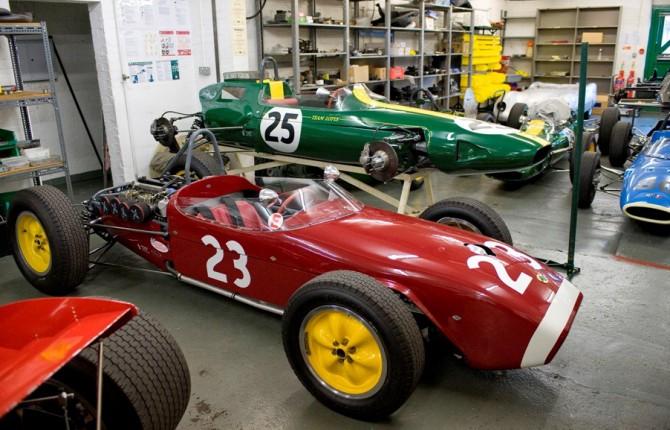
The Classic Team Lotus hosts the Lotus 25 with which Jim Clark and the British manufacturer 50 years ago won their first F1 world titles. By Paolo Ferrini, 06 December 2013.
Monza, Sunday 8 September 1963. Colin Chapman does the lap of honor astride the engine bonnet of Jim Clark's Lotus 25. It is a very special afternoon for the British manufacturer. By winning the Italian GP, Clark and Lotus won their first Formula 1 world titles.
More than half a century has passed since then. What happened to that legendary single-seater and the others who wrote the history of the English firm? To see them again and maybe touch them with your hand, just go to Hethel, in Northern England. In the vicinity of the Lotus Cars headquarters, where the new grand touring are built, the Classic Team Lotus exists since 1991 and is managed, needless to say, by Clive Chapman, son of the great Colin.
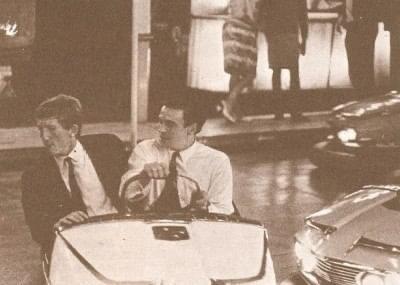
Jochen Rindt and Jim Clark having fun on bumper cars.
Here, in addition to the green-yellow type 25 of Clark (marked by an emblematic number 25), there are, for example, the red-white-gold type 49 of the Gold Leaf Team Lotus world champion 1970 with Jochen Rindt and, obviously, the John Players Special black-gold cars of the late seventies.
"At the beginning of the nineties we came across an important collection of cars that we absolutely had to take care of and thus the idea of creating a specialized workshop was born," Clive Chapman recalls. "I obviously love all the Lotus, but I have a particular fondness for all the John Players Specials. Maybe because they are those of my youth," Clive admits. "As for the drivers, Jim Clark certainly played a very important part in the history of Lotus."
Lotus celebrates: a tribute to Ayrton Senna.

The British manufacturer commemorates the 35th anniversary of the legendary Brazilian driver's first Formula 1 victory. By Vincenzo Borgomeo, April 21, 2020.
Lotus 97T F1, on April 21, 1985, Estoril circuit, pouring rain: Ayrton Senna da Silva is about to enter the legend and Lotus celebrates the 35th anniversary of the first victory in Formula 1 of its Brazilian driver in a very special way, making him remember by his mechanic, Chris Dinnage.
A desire that led him to put his most direct pursuers a minute behind. It was Ayrton's second race with Lotus, but he already mastered the 97T as if he had always driven it. And so he took home the first of 41 F1 victories of his career. But, above all, he definitely entered the legend that would see him become a global sports icon and a national hero in his native Brazil.
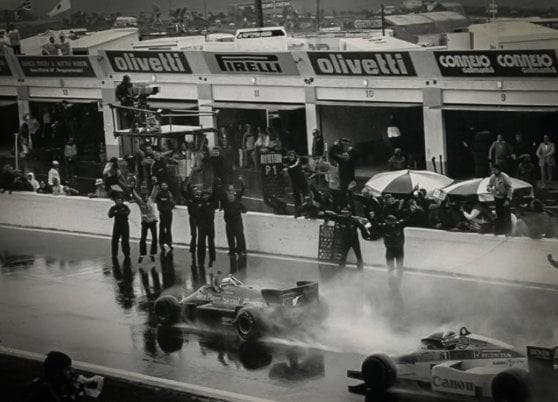
Today Lotus celebrates the occasion with a series of never-before-seen archive images (these are the ones you see on this page), just out of a private collection. But let's go back to his mechanic, who still remembers the amazement of that day.
"Ayrton, Dinnage explains 35 years later, remembering the crazy monsoonal conditions of the track and a young Brazilian who had just turned 25 with an incredible desire to stand out, had never tried the car in the wet: that was the first time he drove in those conditions... The secret? Ayrton used only 50% of his driving ability when he went at the same pace as all the other drivers and he brought out the other 50% in special conditions, like that day in Estoril. His concentration levels were unmatched: I never met anyone else like him."
"The rain, as always, his mechanic adds, is the great leveler for track performances. It requires very delicate commands from the driver, instinctive control of the car and a unique cold blood." Dennis is right and it is no coincidence that Senna has been the king of poles for years (65!), surpassed only by Michael Schumacher and Lewis Hamilton. When it came to doing the fastest lap, Ayrton probably gave 100 per cent. And in those conditions, like that day in Estoril 35 years ago, he was unrivalled.
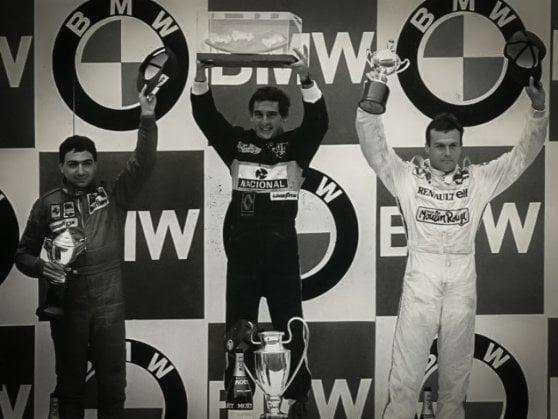
The podium of the Estoril GP. From left, Michele Alboreto, Ayrton Senna and Patrick Tambay.
Happy birthday unforgettable Lotus. The famous English firm turns 50. 21.09.1998.
With a party that will remain in the memory of all British car enthusiasts for a long time, Lotus celebrated its 50th birthday in its historic location in Hethel. About 2.000 the Lotus from all corners of the world and over 12.000 the fans who participated in the British mega-party: with these numbers the whole history of the brand founded by the brilliant Colin Chapman was perfectly represented, from the Mark 1 of 1948 to the Formula 1 cars that have conquered the famous 6 world titles in the drivers 'championship and 7 in the manufacturers' championship.
Lotus, a team that made history. The team created by Colin Chapman, which in the past has brought the most important innovations, from the wing to the ground effect to the sponsors, is back in Formula One. By Fabio Pisanu, 09/15/2009.
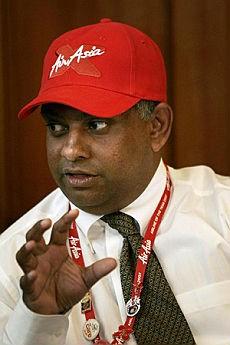
Tony Fernandes.
Now that Lotus is back in F1, the owner of the team, Tony Fernandes, one of the richest men in Malaysia and his technical director, Mike Gascoyne (20 years of F1 behind him with Jordan, Renault, Toyota and Force India) will definitely have to get busy to live up to such a glorious name. And not just for the results; what characterized the English team's 36 years (1958-1994) in F1 is above all the exceptional contribution made to the technological and sporting development of the discipline.
Lotus is about car racing like the Beatles are about pop music: much of what is taken for granted today in conceiving a car or even simply in telling a race is something that was produced years ago by the volcanic founder of the team, Colin Chapman. The exploitation of the ground effect, the ailerons, the active suspensions, the monocoque chassis, the massive use of carbon fiber. And then also apparently minor details, such as the use of "non-technical" sponsorships. Until the 1960s, cars brought national colors to the track: red in the case of Ferrari and other Italian cars, dark green for English firms and so on. Until Chapman, in '68, signed a millionaire agreement with Gold Leaf tobaccos and began to deploy fascinating red and golden cars. He would have traced a path in this too, as demonstrated by the arrival in F1, among others, of Marlboro, Rothmans, John Player Special and Gitanes.
Some of the best drivers in F1 history raced for Chapman.
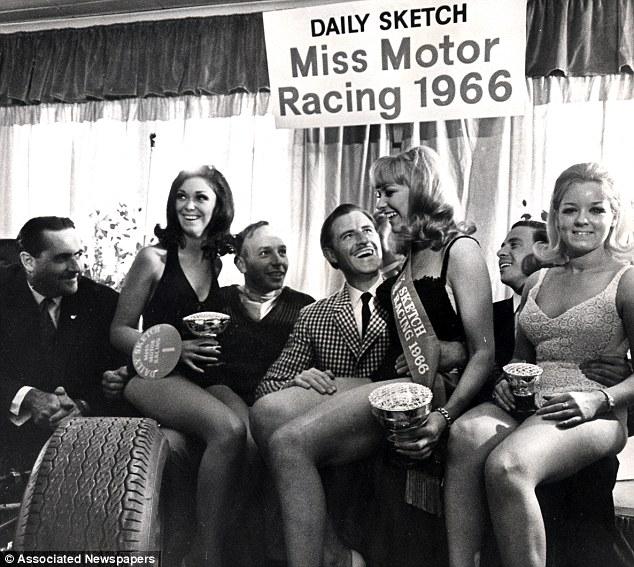
Champions such as Stirling Moss, Graham Hill, Mario Andretti, Emerson Fittipaldi, Nigel Mansell, Mika Hakkinen and - in the last years before the disappearance - Ayrton Senna who, precisely with the English company, took his first victory.

But the Lotus man par excellence was Jim Clark, "the flying Scotsman". Arrived in Norfolk in 1960, in eight years he took 25 victories, 33 pole positions, two world titles and a 500-mile Indianapolis. A streak of successes abruptly interrupted by the accident which, on April 7, 1968, killed him.
A tragic story, like many others that have characterized the history of the team. Innovative on a technical level but often under accusation for the extreme technical solutions that, according to many critics, endangered the pilots.
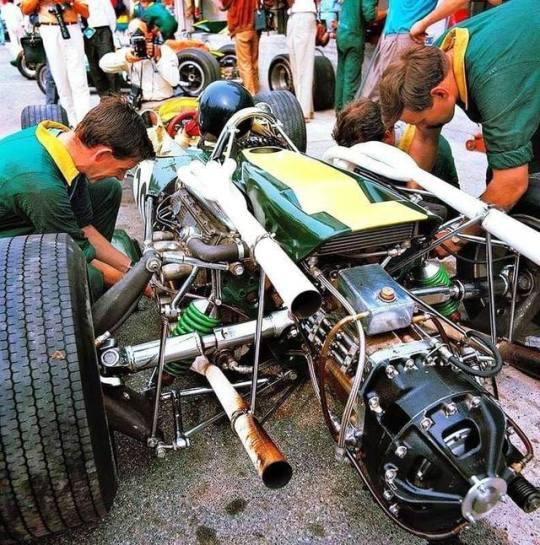
Jim Clark, Lotus-BRM 43, at the Italian Grand Prix in Monza. Photo by Tumblr. Source UK Racing History.
On board the Lotus, in addition to Clark, will find death, among the controversies, Jochen Rindt (Monza '70) and Ronnie Peterson (Monza '78). Episodes which, although deeply grieving Chapman, did not appease his inventiveness. And that allowed the entry into the history of F1 of "outlawed jewels" such as the double-chassis Lotus 88 and the turbine 56B. Fernandes and Gascoyne, perhaps, should start rolling up their sleeves.
Among the heroes who have driven a Lotus in the history of F1, there is also Alex Zanardi: «even if this one, this Lotus, is very different from mine...» In what? «Already from factory headquarters. Old Lotus was in Ketteringham Castle, a place full of grass, fawns and fallow deers. They told me that, after a certain hour, you could see Colin Chapman's ghost." The founder. "Yes. The man who created the myth.” How did he do it? "He was the last of the great garage owners. Man animated by an infinite passion. One of those who spent hours alone in the workshop watching his car at the end of the day. Always ahead of others, on research and development he had a crazy ability to innovate and in an era where the difference was not in detail like today.
Today you recognize the cars by the colors, for the rest they are all the same; at one time you distinguished them from forms, which were ideas and Chapman had more than others». What do you think, instead, of this Lotus? “Beyond the pleasure of seeing an historic brand fight again, I think it's closer to Toleman than Lotus. In fact, it was the old Renault that had taken over Benetton who, in turn, was Toleman's "daughter"». And apart from the pedigree? «I said that, in my opinion, it would hardly have done better than 2012. I was wrong. It is the only car that does not have the front end blocked, it uses the suspensions a lot and this makes it much gentler on the tires. An original choice that "risks" paying a lot». Do you like Raikkonen? «The first time I saw him cross the reporters with the helmet on his head so as not to reply, I didn't like him. The sportsman has the duty to tell and to talk about himself. Then I realized that it was a question of character and perhaps also of humility». Have you ever seen the ghost? "No, never."
Lotus, an era comes to an end: it will be produced in China.

Geely has decided: it will invest 1.3 billion for a new plant in the city of Wuhan. SUVs and electric crossovers with large production numbers are coming soon: the target is 150 thousand pieces per year. By Vincenzo Borgomeo, 18 January 2019.
A myth collapses: the very English Lotus will be born in China. The brand that has dominated F1 for years, what has been Jim Clark's "total weapon" (and a more blunt one for Ayrton Senna), who won the Indianapolis 500 and that - thanks to the genius of Colin Chapman - put legendary sport cars on the road, will be born in a new 9 billion yuan (1.3 billion dollars) super factory in the city of Wuhan.

So goodbye also to the technical "purity", the choice to build only very light sport cars, because from this colossal system SUVs, crossovers and electric cars will be born. The Zhejiang Geely Holding Group, owner of the British brand, has decided. Obviously easy to imagine that the brand's basic construction philosophy will also be thrown away because the slogan "Light is Right" cannot make sense with a SUV or an electric car full of batteries. Henry Ford used to say "what isn't there doesn't break". And it revolutionized the way we manufacture cars. Colin Chapman took up this concept and elaborated it in "what doesn't exist doesn't weigh," bringing new ideas of minimalism into the world of supercars. Here, all this "poetry" risks to disappear into thin air because you can't go too thin when it comes to increasing production volumes and churning out new and highly sought-after SUVs to increase sales.
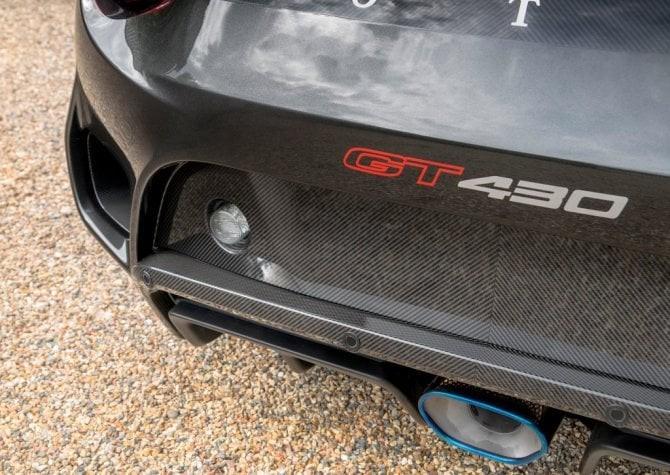
Today the Lotus are built by hand in Norfolk, England. And it is not known whether this small artisan production will remain alongside the large factory or not. What is certain that Geely, in an official statement, said that a fundamental part of the company's strategy to relaunch the British brand goes "through the expansion of the brand's production capacity globally". There is talk of 150.000 cars per year, a monstrous number for the brand that today produces less than 3.000 pieces per year and that will bring Lotus into a new era.
Goodbye Lotus, the electric made in China arrives.
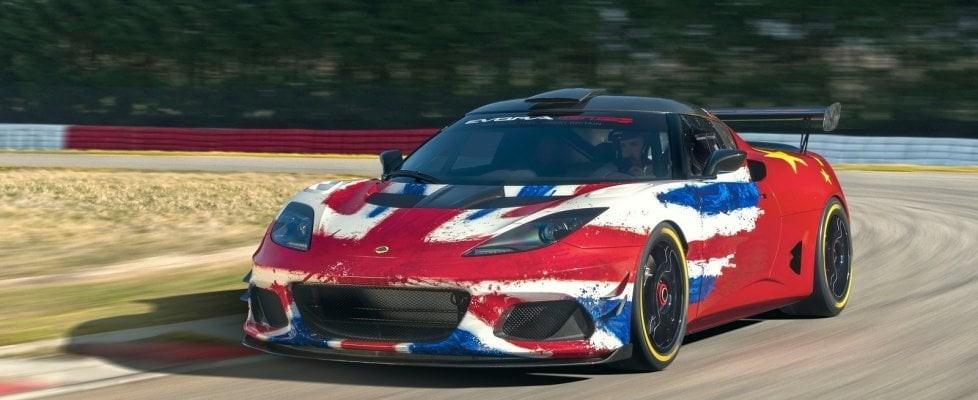
The Zhejiang Geely Holding Group has decided: it will be called Evija. From the F1 cars of Jim Clark and Ayrton Senna to battery-powered cars, the former British manufacturer changes its skin. By Vincenzo Borgomeo, 08 July 2019.
It will be called Evija: here is the name of the next electric Lotus, ready to go on sale starting from next year. The car will be unveiled on July 16th and to date has been known as the "130" project: only 130 specimens will be initially produced. And this because the models produced in 71 years by Lotus are just 130. In short, many historical references to the British soul of the company: it is not even a coincidence that the brand has just unveiled the Lotus Evora GT4 Concept with a giant Union Jack painted on the bodywork.
But, quotes aside, fans are in shock: the very English Lotus will be born in China. And it is not clear whether a small atelier will remain in the historic English location (Norfolk).
And behind the next Evija, however a sports car, a battalion of "normal" electric cars hides. Fortunately, poor Colin Chapman - today he would be 91 years old - is no longer among us and will not be able to witness the destruction of his beloved brand.
Videos
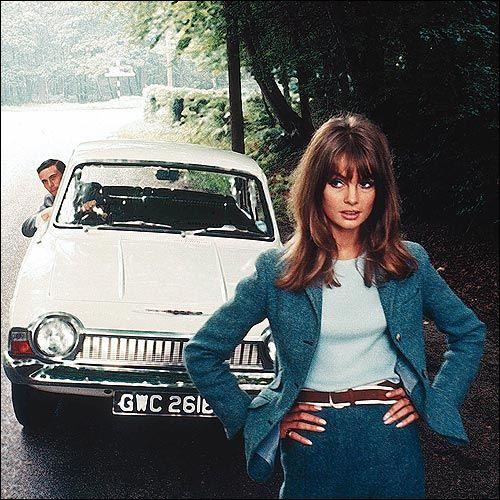



Comments
Authorize to comment